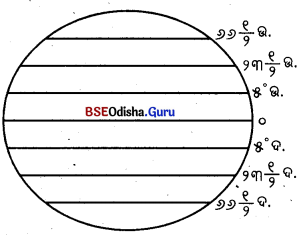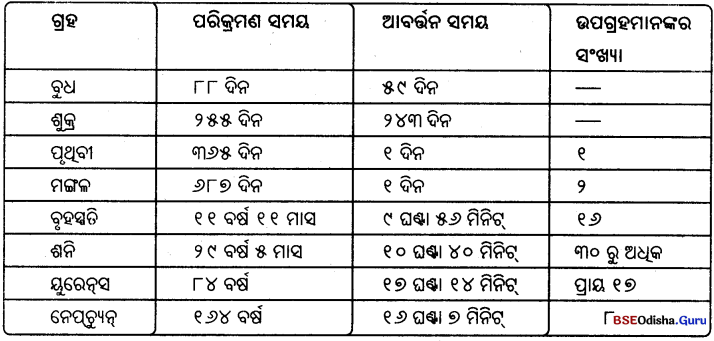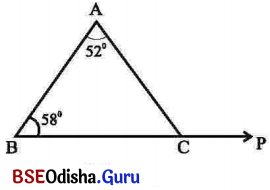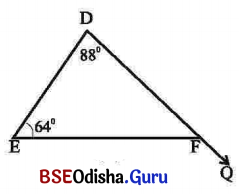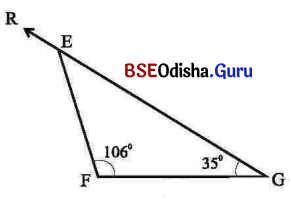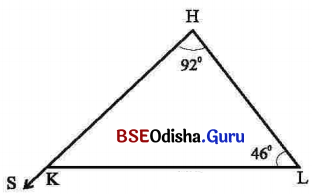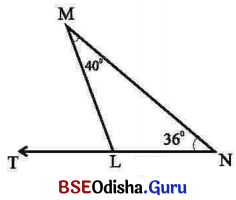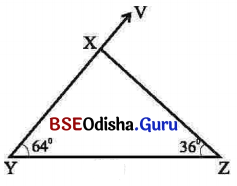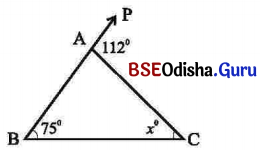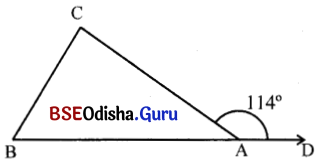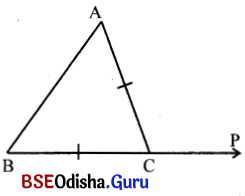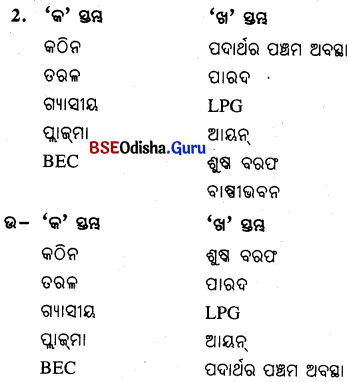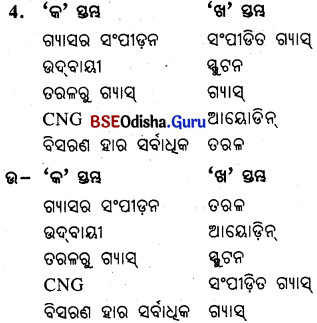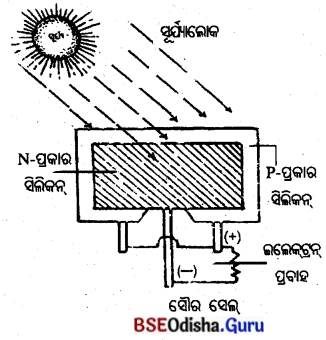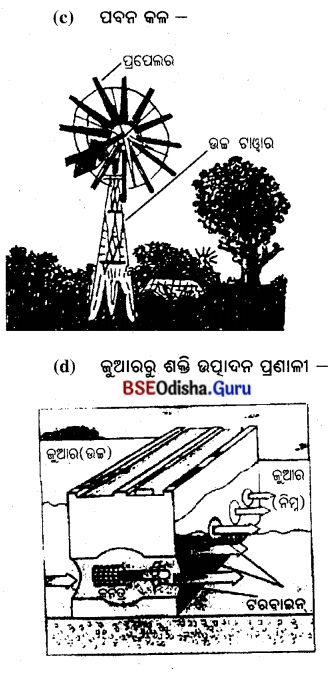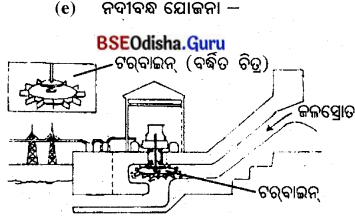Odisha State Board BSE Odisha 7th Class History Important Questions Chapter 2 ଦିଲ୍ଲୀରେ ସୁଲତାନୀ ଶାସନ Important Questions and Answers.
BSE Odisha Class 7 History Important Questions Chapter 2 ଦିଲ୍ଲୀରେ ସୁଲତାନୀ ଶାସନ
Subjective Type Questions With Answers
ଦୀର୍ଘ ଉତ୍ତରମୂଳକ ପ୍ରଶ୍ନୋତ୍ତର
୧। ବିଜୟନଗରର ରାଜାମାନେ ସାହିତ୍ୟ, ସ୍ଥାପତ୍ୟ, ଶିଳ୍ପ ଓ ବାଣିଜ୍ୟ କ୍ଷେତ୍ରରେ କେଉଁସବୁ ଉଲ୍ଲେଖନୀୟ କାର୍ଯ୍ୟ କରିଥିଲେ ?
Answer:
- ବିଜୟନଗରର ରାଜାମାନେ ସେମାନଙ୍କର ଦରବାରରେ ବିଦ୍ବାନ୍ ଲୋକମାନଙ୍କୁ ପ୍ରୋତ୍ସାହିତ କରୁଥିଲେ ।
- ତେଲୁଗୁ ଓ ସଂସ୍କୃତ ସାହିତ୍ୟର ବିକାଶ ପାଇଁ ସେମାନେ ଅନେକ କାର୍ଯ୍ୟ କରୁଥିଲେ ।
- ବିଜୟନଗରର ରାଜାମାନେ ତିଆରି କରିଥିବା ଅନେକ ମନ୍ଦିର ଓ ରାଜପ୍ରାସାଦ ମଧ୍ଯରୁ ହିଜରା ଓ ବିଠାଲ୍ ସ୍ଵାମୀ ମନ୍ଦିର ପ୍ରସିଦ୍ଧ ଥିଲା ।
- ଏହି ରାଜାମାନଙ୍କର ଶାସନ ସମୟରେ କାଠ ଓ ହାତୀଦାନ୍ତର ଖୋଦେଇ କାମ ଶୀର୍ଷସ୍ଥାନରେ ପହଞ୍ଚିଲା ।
- ବିଜୟନଗର ରାଜ୍ୟର ପ୍ରଜାମାନେ ବର୍ମା, ଚୀନ୍, ଆରବ ଓ ଇଉରୋପ ମହାଦେଶର ଲୋକମାନଙ୍କ ସହିତ ବାଣିଜ୍ୟ କାରବାରରେ ପ୍ରସିଦ୍ଧି ଲାଭ କରିଥିଲେ ।
୨ । କେଉଁସବୁ କାରଣରୁ ଇମିସ୍ ଭାରତରେ ସୁଲତାନୀ ଶାସନ ପ୍ରତିଷ୍ଠା କରିଥିଲେ ବୋଲି କୁହାଯାଏ ?
Answer:
- କୁତବୁଦ୍ଦିନ୍ ଆଇବାକ୍ଙ୍କ ପରେ ତାଙ୍କ ଜ୍ୱାଇଁ ସାମସୁଦ୍ଦିନ୍ ଇଲ୍ଡ୍ମିସ୍ ଦିଲ୍ଲୀ ସିଂହାସନ ଆରୋହଣ କରିଥିଲେ ।
- ସୁଲତାନ ହେବା ସମୟରେ ସେ ଅନେକ ସମସ୍ୟାକୁ ଧୈର୍ଯ୍ୟର ସହ ସଫଳ ଭାବରେ ମୁକାବିଲା କରିବା ସହିତ କେତେକଙ୍କୁ ଯୁଦ୍ଧରେ ପରାସ୍ତ କରିଥିଲେ ।
- ତାଙ୍କ ରାଜତ୍ଵ ସମୟରେ ମହାପରାକ୍ରମଶାଳୀ ମଧ୍ୟ-ଏସିଆର ମଙ୍ଗୋଲ ଶାସକ ଚେଙ୍ଗିଜ୍ ଖାଁ ଭାରତ ଆକ୍ରମଣ କରିଥିଲେ ।
- ଚେଙ୍ଗିଜ୍ ଖାଁ ସିନ୍ଧୁ ନଦୀ କୂଳରେ ଥିବା ଅନେକ ଅଞ୍ଚଳ ଦଖଲ କରିଥିଲେ ।
- ମାତ୍ର ଇଲ୍ଡ୍ମିସ୍ଙ୍କର ବିଚକ୍ଷଣ ବୁଦ୍ଧି ଯୋଗୁଁ ଚେଙ୍ଗିଜ୍ ଖାଁ ଭାରତର ଅସ୍ଵୀକାଂଶ ଅଞ୍ଚଳ ଦଖଲ କରିପାରି ନଥିଲେ ।
- ଏହିପରି ଭାବରେ ପ୍ରାଦେଶିକ ଓ ସାମ୍ରାଜ୍ୟଜନିତ ଅନେକ ସମସ୍ୟାକୁ ସଫଳ ଭାବରେ ସମାଧାନ କରି ଦିଲ୍ଲୀ ଶାସନକୁ ସୁଦୃଢ଼ କରିଥିବାରୁ ଇମିସ୍ ଭାରତରେ ସୁଲତାନୀ ଶାସନ ପ୍ରତିଷ୍ଠା କରିଥିଲେ ବୋଲି କୁହାଯାଏ ।
୩ । ଦାସ ବଂଶର ପ୍ରତିଷ୍ଠାତା କିଏ ? ତାଙ୍କର ଜୀବନୀ ଓ କାର୍ଯ୍ୟାବଳୀ ବିଷୟରେ ଏକ ବିବରଣୀ ଦିଅ । କିମ୍ବା, କୁତବୁଦ୍ଦିନ୍ ଆଇବାକ୍ଙ୍କ କୃତିତ୍ଵ ସଂକ୍ଷେପରେ ଲେଖ ।
- କୁତବୁଦ୍ଦିନ୍ ଆଇବାକ୍ ଦାସ ବଂଶର ପ୍ରତିଷ୍ଠାତା ଥିଲେ ।
- ସେ ଜୀବନର ପ୍ରଥମ ଅବସ୍ଥାରେ ମହମ୍ମଦ ଘୋରୀଙ୍କର ଜଣେ ଦାସ ଥିଲେ ।
- ନିଜର ଅସାଧାରଣ ପ୍ରତିଭା ବଳରେ ସେ ମହମ୍ମଦ ଘୋରୀଙ୍କର ପ୍ରଧାନ ସେନାଧ୍ୟକ୍ଷ ହୋଇପାରିଥିଲେ ଓ ଉତ୍ତର ଭାରତ ଜୟ କରିବା ଦାୟିତ୍ଵରେ ଥିଲେ ।
- ମହମ୍ମଦ ଘୋରୀଙ୍କ ମୃତ୍ୟୁ ପରେ ସେ ୧୨୦୬ ଖ୍ରୀଷ୍ଟାବ୍ଦରେ ଦିଲ୍ଲୀ ସିଂହାସନ ଆରୋହାଣ କରିଥିଲେ । ତା’ ପୂର୍ବରୁ ସେ ଦିଲ୍ଲୀ, କୋଲି (ଆଲିଗଡ଼), କନୌଜ, ବିହାର ଆଦି ରାଜ୍ୟ ଜୟ କରିଥିଲେ ।
- ସେ ଅନେକ ଜ୍ଞାନୀଗୁଣୀ ଲୋକଙ୍କର ପୃଷ୍ଠପୋଷକତା କରିଥିଲେ । ସେ ଦିଲ୍ଲୀ ଓ ଆଜମିରରେ ଅନେକ ମସଜିଦ୍ ନିର୍ମାଣ କରିଥିଲେ । ସେ ଦିଲ୍ଲୀରେ କୁତୁବ୍ମିନାର ନିର୍ମାଣ କାର୍ଯ୍ୟ ଆରମ୍ଭ କରିଥିଲେ ।
- ସେ ୪ ବର୍ଷ ପର୍ଯ୍ୟନ୍ତ ରାଜ୍ୟ ଶାସନ କରିଥିଲେ । ପୋଲୋ ଖେଳୁଥିବା ସମୟରେ ଘୋଡ଼ା ପିଠିରୁ ଖସିପଡ଼ି ସେ ଅକାଳ ମୃତ୍ୟୁବରଣ କରିଥିଲେ ।

୪। ମହମ୍ମଦ୍ ବିନ୍ ତୁଗ୍ଲକ୍ଙ୍କ ଯୋଜନାଗୁଡ଼ିକ କାହିଁକି ଓ କିପରି ବିଫଳ ହୋଇଥିଲା ?
Answer:
- ମହମ୍ମଦ ବିନ୍ ତୁଗ୍ଲକ୍ ଜଣେ ଆଦର୍ଶବାଦୀ ରାଜା ଥିଲେ । ପ୍ରଜାମାନଙ୍କ ହିତ ପାଇଁ ସେ ଅନେକ ପଦକ୍ଷେପ ନେଇଥିଲେ ମଧ୍ୟ ଦୃଢ଼ ମନୋବଳ ଓ ଧୈର୍ଯ୍ୟ ଅଭାବରୁ ଯୋଜନାଗୁଡ଼ିକୁ କାର୍ଯ୍ୟକାରୀ କରିପାରି ନଥିଲେ ।
- ତାଙ୍କର ପ୍ରଥମ ଯୋଜନା ଥିଲା ଦୋଆବ ଅଞ୍ଚଳରେ କରବୃଦ୍ଧି । ସେ ମଧ୍ୟ-ଏସିଆର କେତେକ ରାଜ୍ୟ ଜୟ କରିବାପାଇଁ ଇଚ୍ଛା କରିଥିଲେ । ଏଥିପାଇଁ ଆବଶ୍ୟକ ବିଶାଳ ସୈନ୍ୟବାହିନୀର ଖର୍ଚ୍ଚ ତୁଲାଇବାପାଇଁ ଅର୍ଥ ଯୋଗାଡ଼ ନିମନ୍ତେ ସେ ଗଙ୍ଗା ଓ ଯମୁନାର ମଧ୍ୟବର୍ତ୍ତୀ ଦୋଆବ ଅଞ୍ଚଳରେ କରବୃଦ୍ଧି କରିଥିଲେ । ଦୁର୍ଯୋଗକୁ ସେ ବର୍ଷ ମରୁଡ଼ି ପଡ଼ିଥିଲା ଓ ଲୋକମାନେ ବର୍ଷିତ କର ଦେଇପାରି ନଥିଲେ । ସେ ଚାଷୀମାନଙ୍କଠାରୁ ଜବରଦସ୍ତ କର ଆଦାୟ କରିବାକୁ ଆଦେଶ ଦେଲେ । ରାଜସ୍ୱ ଆଦାୟକାରୀମାନେ ଚାଷୀମାନଙ୍କ ଉପରେ ବଳ ପ୍ରୟୋଗ କଲେ ଓ ଚାଷୀମାନେ ଜଙ୍ଗଲକୁ ପଳାୟନ କଲେ । ଶେଷରେ ସୁଲତାନ୍ ନିଜର ଭୁଲ୍ ବୁଝିପାରି ବର୍ଷିତ କର ଆଦାୟ ନ କରିବାକୁ ନିର୍ଦ୍ଦେଶ ଦେଇଥିଲେ ।
- ତାଙ୍କର ଦ୍ବିତୀୟ ଯୋଜନାଟି ଥୁଲା ରାଜଧାନୀ ପରିବର୍ତ୍ତନ । ସେ ମଙ୍ଗୋଲମାନଙ୍କ ଆକ୍ରମଣରୁ ଦେଶକୁ ରକ୍ଷା କରିବା ଓ ଦାକ୍ଷିଣାତ୍ୟକୁ ସହଜରେ ନିୟନ୍ତ୍ରଣ କରିବା ନିମନ୍ତେ ଦିଲ୍ଲୀରୁ ଦୌଲତାବାଦକୁ ରାଜଧାନୀ ଉଠାଇ ନେଇଥିଲେ । ଦିଲ୍ଲୀର ସମସ୍ତ ଅଧିବାସୀଙ୍କୁ ସେଠାକୁ ଜରବଦସ୍ତ ନିଆଯାଇଥିଲା। ମାତ୍ର ସେଠାରୁ ସେ ଉତ୍ତର ଭାରତ ଉପରେ ନିଜର ନିୟନ୍ତ୍ରଣ ରଖୁରିଲେ ନାହିଁ । ସୁତରାଂ ଏକ ବର୍ଷ ପରେ ସେ ଦୌଲତାବାଦରୁ ପୁଣି ଦିଲ୍ଲୀକୁ ରାଜଧାନୀ ଫେରାଇ ଆଣିଥିଲେ । ଏହା ଫଳରେ ଲୋକମାନେ ବହୁ ଦୁଃଖଦୁର୍ଦ୍ଦଶା ଭୋଗ କରିଥିଲେ । କେତେକ ଲୋକ ମଧ୍ୟ ବାଟରେ ପ୍ରାଣ ହରାଇଥିଲେ ।
- ତାଙ୍କର ତୃତୀୟ ଯୋଜନାଟି ଥୁଲା ତାମ୍ର ମୁଦ୍ରା ପ୍ରଚଳନ । ଏହାର ଉଦ୍ଦେଶ୍ୟ ଥିଲା ଶୂନ୍ୟ ରାଜକୋଷକୁ ପୂରଣ କରିବା । ତମ୍ବା ଟଙ୍କା ବଦଳରେ ଲୋକମାନେ ସରକାରୀ ରାଜକୋଷରୁ ସୁନା ଓ ରୁପା ଟଙ୍କା ନେଇପାରିବେ ବୋଲି ଆଦେଶ ଦିଆଯାଇଥିଲା । ଲୋକେ ଏହାର ସୁଯୋଗ ନେଇ ଘରେ ଘରେ ତମ୍ବା ଟଙ୍କା ତିଆରି କରି ରାଜକୋଷରୁ ସୁନା ଓ ରୁପା ଟଙ୍କା ବଦଳାଇ ନେଲେ । ଏହା ଫଳରେ ରାଜକୋଷ ଅର୍ଥଶୂନ୍ୟ ହେବାକୁ ଲାଗିଲା । ସେ ଏହା ଜାଣିପାରି ନିଜ ଆଦେଶକୁ ପ୍ରତ୍ୟାହାର କରିନେଇଥିଲେ ।
୫। ଦିଲ୍ଲୀର ସୁଲତାନୀ ଶାସନ ସମ୍ବନ୍ଧରେ ଏକ ସଂକ୍ଷିପ୍ତ ସନ୍ଦର୍ଭ ଲେଖ ।
Answer:
- ସୁଲତାନୀ ଶାସନରେ ସୁଲତାନ କେନ୍ଦ୍ର ଶାସନର ମୁଖ୍ୟ ଥିଲେ । ସେ ନିଜେ ଶାସନ ଓ ସୈନ୍ୟବିଭାଗର ସର୍ବୋଚ୍ଚ କର୍ତ୍ତା ଥିଲେ । କେତେଜଣ ମନ୍ତ୍ରୀ ତାଙ୍କୁ ଶାସନ କାର୍ଯ୍ୟରେ ସାହାଯ୍ୟ କରୁଥିଲେ ।
- ୱାଜିର ତାଙ୍କର ପ୍ରଧାନମନ୍ତ୍ରୀ ଥିଲେ । ସେ ସାମରିକ ଓ ରାଜସ୍ବ ବିଭାଗର ଦାୟିତ୍ଵରେ ଥିଲେ । ବକ୍ସି ସେନାବାହିନୀର ଦରମା ଦାୟିତ୍ବରେ ଥିଲେ । କାଜି ବିଚାର ବିଭାଗ ଦାୟିତ୍ଵ ତୁଲାଉଥିଲେ ।
- ଦିୱାନ-ଇ-ଇନଖା ଚିଠିପତ୍ର ଦାୟିତ୍ଵ ତୁଲାଉଥଲାବେଳେ ବାରିଦ-ଇ-ମାମାଲିକ୍ ଖବର ସରବରାହ ସଂସ୍ଥାର ମୁଖ୍ୟ ଥିଲେ ।
- ଭୂରାଜସ୍ବ ରାଜ୍ୟର ମୁଖ୍ୟ ଆୟ ଥିଲା। ଉତ୍ପନ୍ନ ଶସ୍ୟର ଏକ ତୃତୀୟାଂଶ କରରୂପେ ଆଦାୟ କରାଯାଉଥିଲା । ଜାକତ, ଜିଜିୟା ଓ ଉସର୍ ଆଦି ପାଞ୍ଚ ପ୍ରକାର କର ପ୍ରଜାମାନଙ୍କଠାରୁ ଆଦାୟ କରାଯାଉଥିଲା ।
- ସୁଲତାନମାନେ କୃଷିର ଉନ୍ନତି ଲାଗି ଏକ କୃଷି ବିଭାଗ ପ୍ରତିଷ୍ଠା କରିଥିଲେ ।
- ବଜାର ଦର ତଥା ବିଭିନ୍ନ ଦ୍ରବ୍ୟର ମାପ ଓ ଓଜନ ଆଇନଦ୍ୱାରା ନିୟନ୍ତ୍ରିତ ଥିଲା । କଳାବଜାରୀ ଓ ଖାଦ୍ୟଶସ୍ୟ ମହଜୁଦକାରୀଙ୍କୁ କଠୋର ଶାସ୍ତି ଦିଆଯାଉଥିଲା ।
- ଜନସାଧାରଣଙ୍କ ଶିକ୍ଷା ଓ ସ୍ୱାସ୍ଥ୍ୟ ପ୍ରତି ଯଥେଷ୍ଟ ଧ୍ୟାନ ଦିଆଯାଉଥିଲା । ଏଥ୍ ନିମନ୍ତେ ଅନେକ ବିଦ୍ୟାଳୟ, ଦାତବ୍ୟ ଚିକିତ୍ସାଳୟମାନ ପ୍ରତିଷ୍ଠା କରାଯାଇଥିଲା ।
୬। ମହମ୍ମଦ୍ ବିନ୍ ତୁପ୍ଲକ୍ଙ୍କ ଚରିତ୍ର ଚିତ୍ରଣ କର ।
Answer:
- ମହମ୍ମଦ ବିନ୍ ତୁଘଲକ୍ ଥିଲେ ଜଣେ ଅତି ଆଦର୍ଶବାଦୀ ରାଜା । ସେ ସରଳ, ନିରାଡ଼ମ୍ବର ଓ ଦାନଶୀଳ ଶାସକ ଥିଲେ ।
- ସେ ଗଣିତଶାସ୍ତ୍ର, ତର୍କଶାସ୍ତ୍ର, ଦର୍ଶନଶାସ୍ତ୍ର ଓ ଧର୍ମଶାସ୍ତ୍ର ଆଦିରେ ଅତି ପ୍ରବୀଣ ଥିଲେ । ସେ ଜଣେ ସୁପ୍ରତିଷ୍ଠିତ କବି ଓ ସାହିତ୍ୟିକ ମଧ୍ୟ ଥିଲେ ।
- ତାଙ୍କର ସମସ୍ତ ଯୋଜନା ସାମ୍ରାଜ୍ୟ ଓ ଜନସାଧାରଣଙ୍କ ଉନ୍ନତି ପାଇଁ ଉଦ୍ଦିଷ୍ଟ ଥିଲା । ମାତ୍ର ଦୃଢ଼ ମନୋବଳର ଅଭାବରୁ ସେ କୌଣସି କାର୍ଯ୍ୟକୁ ଶେଷ ପର୍ଯ୍ୟନ୍ତ ଚଳାଇ ରଖିପାରୁ ନଥିଲେ ।
- ସେ ଅତ୍ୟନ୍ତ ଉଚ୍ଚାଭିଳାଷୀ ଥିଲେ । ମାତ୍ର ଦୂରଦୃଷ୍ଟି ଓ ଧୈର୍ଯ୍ୟର ଅତ୍ୟନ୍ତ ଅଭାବ ଥିବାରୁ ତାଙ୍କର କୌଣସି ଯୋଜନା ଫଳବତୀ ହୋଇପାରି ନଥିଲା ।
- ମୋଟ ଉପରେ ସେ ଜଣେ ଅତି ଜ୍ଞାନୀ, ଗୁଣୀ, ଧାର୍ମିକ, ପ୍ରଜାହୈତେଷୀ ଓ ଉଚ୍ଚାଭିଳାଷୀ ରାଜା ଥିଲେ; ମାତ୍ର ତାଙ୍କର ଦୂରଦୃଷ୍ଟି, ମନୋବଳ ଓ ଧୈର୍ଯ୍ୟର ଅଭାବ ଯୋଗୁ ସେ କୌଣସି କ୍ଷେତ୍ରରେ ସଫଳ ହୋଇପାରି ନଥିଲେ । ସେଥିପାଇଁ ଲୋକମାନେ ତାଙ୍କୁ ଆଡ଼ବାୟା ରାଜା ବୋଲି କହିଥା’ନ୍ତି ।
୭ । ଦିଲ୍ଲୀରେ ସୁଲତାନୀ ଶାସନ ସମୟରେ କେଉଁ ମଙ୍ଗୋଲ ଶାସକ ଭାରତ ଆକ୍ରମଣ କରିଥିଲେ ? ତାଙ୍କ ଆକ୍ରମଣର ଫଳାଫଳ କ’ଣ ହେଲା ?
Answer:
- ଦିଲ୍ଲୀରେ ସୁଲତାନୀ ଶାସନ ସମୟରେ ମଧ-ଏସିଆର ମଙ୍ଗୋଲ ଶାସକ ଚେଙ୍ଗିଜ୍ ଖାଁ ଭାରତ ଆକ୍ରମଣ କରିଥିଲେ । ସେତେବେଳେ ଇମିସ୍ ଦିଲ୍ଲୀର ସୁଲତାନ୍ ଥିଲେ ।
- ଚେଙ୍ଗିଜ୍ ଖାଁ ସିନ୍ଧୁ ନଦୀ କୂଳରେ ଥିବା ଅନେକ ଅଞ୍ଚଳ ଅଧୁକାର କରିନେଇଥିଲେ ।
- ଇଲଡ୍ମିସ୍ଙ୍କ ବିଚକ୍ଷଣ ବୁଦ୍ଧି ଯୋଗୁଁ ଚେଙ୍ଗିଜ୍ ଖାଁ ଭାରତର ଅଧ୍ଵ ଅଞ୍ଚଳ ଦଖଲ ପାଇଁ ଅଗ୍ରସର ହୋଇପାରି ନଥିଲେ ।
- ଫଳରେ ଦିଲ୍ଲୀରେ ସୁଲତାନୀ ସାମ୍ରାଜ୍ୟର କୌଣସି କ୍ଷତି ହୋଇ ନ ଥିଲା ।

୮। ତୁର୍କ-ଆଫଗାନ୍ମାନଙ୍କ ଆଗମନ ଭାରତୀୟ କଳା ଓ ଭାସ୍କର୍ଯ୍ୟକୁ କିପରି ପ୍ରଭାବିତ କରିଥିଲା ଲେଖ ।
Answer:
ତୁର୍କ-ଆଫଗାନ୍ମାନେ ମଧ୍ୟ-ଏସିଆ ଓ ପାରସ୍ୟରୁ ଆଣିଥିବା କଳା ଓ ସ୍ଥାପତ୍ୟ ସହିତ ଭାରତୀୟ କଳା ଓ ସ୍ଥାପତ୍ୟ ମିଶି ଏକ ନୂତନ କଳା ଓ ସ୍ଥାପତ୍ୟ ଜନ୍ମ ନେଇଥିଲା । ଏହାକୁ ଇଣ୍ଡୋ-ଇସ୍ଲାମୀୟ କଳା ଓ ସ୍ଥାପତ୍ୟ କୁହାଯାଏ ।
- ଚାପ ଓ ଗମ୍ବୁଜର ବ୍ୟବହାର ପ୍ରଥମ ଥର ପାଇଁ ଏହି ସମୟରେ ଭାରତୀୟ କଳା ଓ ଭାସ୍କର୍ଯ୍ୟରେ ଦେଖିବାକୁ ମିଳିଥିଲା ।
- ଗାଣିତିକ ଜ୍ଞାନ ଓ ଯାନ୍ତ୍ରିକ ବିଦ୍ୟା ପ୍ରୟୋଗ କରାଯାଇ ଗମ୍ବୁଜର ଛାତ ଅର୍ଦ୍ଧ ବୃତ୍ତାକାର କରାଯାଉଥିଲା ।
- ମୀନାର ତିଆରି କରିବାପାଇଁ ପଥର ଉପରେ ପଥର ଲମ୍ବ ଓ ତିର୍ଯ୍ୟକ ଭାବେ ରଖାଯାଉଥିଲା ।
- ଭାରତୀୟମାନଙ୍କ ସ୍ଥାପତ୍ୟ ଶୈଳୀ ଦିଲ୍ଲୀ ସୁଲତାନମାନଙ୍କୁ ଆକୃଷ୍ଟ କରିଥିଲା ।
- ଏହି କଳା ଓ ସ୍ଥାପତ୍ୟ ଶୈଳୀ ଉପଯୋଗ କରି କୁତ୍ବୁଦ୍ଦିନ୍ ଆଇବାକ୍ ଦିଲ୍ଲୀଠାରେ ପ୍ରସିଦ୍ଧ କ୍ଵାତ୍-ଉଲ-ଇସ୍ଲାମ୍ ଓ ଢାଇ-ଦିନ୍ ଝୋପରା ନାମକ ଦୁଇଟି ମସ୍ଜିଦ୍ ନିର୍ମାଣ କରିଥିଲେ ।
୯। ବିଜୟନଗର ରାଜ୍ୟର ମୂଳଦୁଆ କିଏ ପକାଇଥିଲେ ? ଏହି ରାଜ୍ୟର ଶ୍ରେଷ୍ଠ ରାଜାଙ୍କ ବିଷୟରେ ଏକ ଟିପ୍ପଣୀ ଲେଖ । ଏହି ରାଜ୍ୟର ପତନ କିପରି ଘଟିଥିଲା ?
Answer:
- ହରିହର ଓ ବ୍ଳକା ନାମକ ଦୁଇ ଭାଇ ହୟଶାଳ ରାଜ୍ୟ ଜୟ କରି ବିଜୟନଗର ରାଜ୍ୟର ମୂଳଦୁଆ ପକାଇଥିଲେ ।
- ଏହି ରାଜ୍ୟକୁ ସମୁଦାୟ ୧୬ ଜଣ ରାଜା ୨୩୦ ବର୍ଷଧରି ଶାସନ କରିଥିଲେ । ଏହି ରାଜ୍ୟ ସଙ୍ଗମ, ତୁଳୁଭ, ସାଲୁଭ ବଂଶଦ୍ୱାରା ଶାସିତ ହୋଇଥିଲା ।
- ସମସ୍ତ ରାଜାମାନଙ୍କ ମଧ୍ୟରେ ତୁଳୁଭ ବଂଶର କୃଷ୍ଣଦେବରାୟ ଶ୍ରେଷ୍ଠ ଥିଲେ ।
- ସେ ଶତ୍ରୁଙ୍କ ପ୍ରତି ପ୍ରତିଶୋଧପରାୟଣ ନ ଥିଲେ । ସେ ସବୁଧର୍ମର ଲୋକମାନଙ୍କୁ ସମାନ ଦୃଷ୍ଟିରେ ଦେଖୁଥିଲେ । ତାଙ୍କ ରାଜୁତି କାଳରେ ବିଜୟନଗର ରାଜ୍ୟର ଖ୍ୟାତି ବଢ଼ିଯାଇଥିଲା ।
- ରାମରାୟାଙ୍କ ଶାସନକାଳରେ ବାହମନୀ ରାଜ୍ୟର ସବୁ ମୁସଲମାନ ଶକ୍ତି ମିଶି ୧୫୬୫ ଖ୍ରୀ.ଅ. ରେ ଏକ ଯୁଦ୍ଧରେ ତାଲିକୋଟାଠାରେ ବିଜୟନଗରକୁ ପରାସ୍ତ କରି ବିଜୟନଗର ରାଜ୍ୟର ପତନ ଘଟାଇଥିଲେ ।
୧୦ । ବିଜୟନଗର ରାଜ୍ୟ କିଏ ପ୍ରତିଷ୍ଠା କରିଥିଲେ ? ଏହା କେଉଁ ରାଜ୍ୟ ସହିତ ସଂଘର୍ଷରେ ବ୍ୟାପୃତ ରହିଥିଲା ?
Answer:
- ବିଜୟନଗର ରାଜ୍ୟକୁ ହରିହର ଓ ବୁକା ନାମକ ଦୁଇଭାଇ ୧୩୩୬ ଖ୍ରୀ.ଅ.ରେ ପ୍ରତିଷ୍ଠା କରିଥିଲେ ।
- ବାହାମନୀ ରାଜ୍ୟ ସହିତ ଏହି ରାଜ୍ୟ ସଂଘର୍ଷରେ ବ୍ୟାପୃତ ରହିଥିଲା ।
- ଏହା ମୂଳରେ ୩ଟି କାରଣ ନିହିତ ଥିଲା । ସେଗୁଡ଼ିକ ହେଲା-
(୧) ରାଇଚୁରକୁ ନିଜ ଅଧୀନର ରଖୁ,
(୨) ଗୋଲକୁଣ୍ଡାରେ ପ୍ରଚୁର ହୀରା ମିଳୁଥିବାରୁ ଏହାକୁ ଦଖଲରେ ରଖୁ,
(୩) ଉଭୟ ରାଜ୍ୟର ରାଜାମାନଙ୍କର ରାଜ୍ୟ ଜୟ କରିବାର ପ୍ରବଳ ଆଗ୍ରହ ।
୧୧। ବଲ୍ବନ୍ ଶାସନର ସୁପରିଚାଳନା ଏବଂ କଳା ଓ ସାହିତ୍ୟର ବିକାଶ ପାଇଁ କେଉଁସବୁ ପଦକ୍ଷେପ ନେଇଥିଲେ ?
Answer:
- ବଲ୍ବନ୍ ତାଙ୍କ ସାମ୍ରାଜ୍ୟର ସୁପରିଚାଳନା ପାଇଁ ଶାସନ ଓ ସାମାଜିକ କ୍ଷେତ୍ରରେ ଅନେକ ପରିବର୍ତ୍ତନ ଆଣିଥିଲେ । ତାଙ୍କ ପୃଷ୍ଠପୋଷକତାରେ କଳା ଓ ସାହିତ୍ୟର ବିକାଶ ସାଧ୍ୟ ହୋଇଥିଲା ।
- ସେ ନିଜ ଦରବାରରେ ଅନେକ ଜ୍ଞାନୀ ଓ ବିଦ୍ୱାନ୍ ବ୍ୟକ୍ତିଙ୍କୁ ସ୍ଥାନ ଦେଇଥିଲେ ।
- ପ୍ରସିଦ୍ଧ କବି ଅମୀର ଖୁସ୍ରୁ ତାଙ୍କ ରାଜଦରବାରରେ ସ୍ଥାନ ପାଇଥିଲେ ।
- ବଲବନ୍ ନିଜ ଶାସନକାଳ ମଧ୍ୟରେ ଅନେକଗୁଡ଼ିଏ ମସ୍ଜିଦ୍ ନିର୍ମାଣ କରିଥିଲେ ।
- ଏସବୁ କାର୍ଯ୍ୟାବଳୀ ନିମନ୍ତେ ବଲବନ୍ ଦାସବଂଶର ଶ୍ରେଷ୍ଠ ସମ୍ରାଟ ଭାବେ ବିବେଚିତ ହୋଇଥାଅନ୍ତି ।
୧୨ । ଆଲ୍ଲାଉଦ୍ଦିନ୍ ଖାଲ୍ ଦ୍ୱିତୀୟ ଆଲେକ୍ଜାଣ୍ଡର ହେବାପାଇଁ ଚାହିଁଥିଲେ । ଏ ଦିଗରେ ସେ କି ପଦକ୍ଷେପ ଗ୍ରହଣ କରି କୃତକାର୍ଯ୍ୟ ହୋଇପାରିଥିଲେ ?
Answer:
- ଆଲ୍ଲାଉଦ୍ଦିନ୍ ଖାଲ୍ଜୀ ଦ୍ବିତୀୟ ଆଲେକ୍ଜାଣ୍ଡର ହୋଇ ସମଗ୍ର ପୃଥିବୀକୁ ଜୟ କରିବାର ରଙ୍ଗୀନ୍ ସ୍ୱପ୍ନ ଦେଖୁଥିଲେ । ମାତ୍ର ବୃଦ୍ଧ ପାରିଷଦ ଆଲ୍ଲା ଉଲ୍ ମୁଲକ୍ଙ୍କ ପରାମର୍ଶରେ ସାରା ଭାରତ ଜୟ କରିବାକୁ ସ୍ଥିର କରିଥିଲେ ।
- ଏଥୁଁନିମନ୍ତେ ଏକ ବିରାଟ ସେନାବାହିନୀର ଆବଶ୍ୟକତା ପଡ଼ିଥିଲା ।
- ସୈନ୍ୟବାହିନୀର ଖର୍ଚ୍ଚ ତୁଲାଇବା ପାଇଁ ସେ ଦୋଆବ୍ର ଧନୀକ ଶ୍ରେଣୀ ଲୋକଙ୍କ ଉପରେ ଅଧ୍ଵକ କର ବସାଇଥିଲେ । ଏହାଛଡ଼ା ଜମି ମାପ କରାଇ କର ବସାଇଥିଲେ । ଜିନିଷପତ୍ରର ଦରଦାମ୍ ନିୟନ୍ତ୍ରଣ କରିଥିଲେ ।
- ଅନ୍ୟାନ୍ୟ ସୂତ୍ରରୁ ମଧ୍ଯ ଅର୍ଥ ଆଦାୟ କରି ସେ ନିଜର ବିରାଟ ସେନାବାହିନୀ ସାହାଯ୍ୟରେ ତୁର୍କ ସାମନ୍ତମାନଙ୍କ ଶକ୍ତି ହ୍ରାସ କରିଥିଲେ । ୧୨୯୯ ଖ୍ରୀ.ଅ.ରେ ଗୁଜରାଟ, ମାଳବ, ରନ୍ଥମ୍ଭର ଓ ମେୱାରର ଚିତୋର ଦୁର୍ଗ ଅଧ୍ୟାର କରିଥିଲେ । ସେ ସିଓ୍ବାନା ଓ ଜାଲୋର୍ ଇତ୍ୟାଦି ରାଜ୍ୟ ଜୟ କରି ନିଜ ଅଧୀନକୁ ଆଣିଥିଲେ ।
- ଏହାପରେ ସେ ୧୩୦୭ ଖ୍ରୀ.ଅ.ରେ ଦକ୍ଷିଣ ଭାରତ ଅଭିଯାନରେ ସେନାପତି ମାଲିକ୍ କାଫୁରଙ୍କ ନେତୃତ୍ୱରେ ଏକ ବିଶାଳ ସେନାବାହିନୀ ପଠାଇଥିଲେ । ମାଲିକ କାଫୁର ଦେବଗିରି, ତେଲେଙ୍ଗାନା, ଦ୍ଵାରସମୁଦ୍ର, ପାଣ୍ଡ୍ଯ ଓ ହୟଶାଳ ଇତ୍ୟାଦି ରାଜ୍ୟ ଜୟକରି ସମଗ୍ର ଦକ୍ଷିଣ ଭାରତକୁ ନିଜ ଅଧୀନକୁ ଆଣିଥିଲେ । ଏହିପରି ଭାବରେ ସେ ଏକ ବୃହତ୍ ସର୍ବଭାରତୀୟ ସାମ୍ରାଜ୍ୟ ଗଠନ କରି ତାଙ୍କର ଅଭିଳାଷ ପୂରଣ କରିଥିଲେ ।

୧୩ । ସୁଲତାନୀ ଶାସନ କାଳରେ ପ୍ରାଦେଶିକ ରାଜ୍ୟଗୁଡ଼ିକର ଉତ୍ଥାନ କିପରି ଘଟିଥିଲା ?
Answer:
- ସମୟକ୍ରମେ ଦିଲ୍ଲୀରେ ସୁଲତାନୀ ଶାସନର ଦୁର୍ବଳତାର ସୁଯୋଗ ନେଇ ଦିଲ୍ଲୀ ସୁଲତାନଙ୍କ ଅଧୀନରେ ଥିବା ଉତ୍ତର ଓ ଦକ୍ଷିଣ ଭାରତର ଅନେକ ପ୍ରାଦେଶିକ ରାଜା ସେମାନଙ୍କର ସ୍ଵାଧୀନତା ଘୋଷଣା କରି ଦିଲ୍ଲୀ ଶାସନଠାରୁ ଅଲଗା ହୋଇଗଲେ ।
- ଏହାଛଡ଼ା କେତେକ ରାଜପୁତ ରାଜ୍ୟ, ଗୁଜରାଟର କେତେକ ପ୍ରଦେଶ ସେମାନଙ୍କର ସ୍ବାଧୀନତା ଘୋଷଣା କଲେ ।
- ମାଳବ, କାଶ୍ମୀର ଓ ବେଙ୍ଗଲ ଇତ୍ୟାଦି ପ୍ରଦେଶରେ ସ୍ଵାଧୀନ ମୁସଲମାନ ରାଜ୍ୟ ଗଢ଼ିଉଠିଲା ।
- ଏହାବ୍ୟତୀତ ମହମ୍ମଦ ବିନ୍ ତୁଘଲକ୍ଙ୍କ ରାଜତ୍ଵ ସମୟରେ ଦାକ୍ଷିଣାତ୍ୟରେ ତାଙ୍କର କର୍ତ୍ତୃତ୍ତ୍ଵ କମିଯିବାରୁ ଅନେକଗୁଡ଼ିଏ ରାଜ୍ୟ ମୁଣ୍ଡ ଟେକି ଉଠିଥିଲା । ଏହି ରାଜ୍ୟଗୁଡ଼ିକ ମଧ୍ୟରେ ବାହାମନୀ ଓ ବିଜୟନଗର ରାଜ୍ୟ ଅନ୍ୟତମ । ଉପରୋକ୍ତ କାରଣଗୁଡ଼ିକ ଯୋଗୁଁ ପ୍ରାଦେଶିକ ରାଜ୍ୟଗୁଡ଼ିକର ଉତ୍ଥାନ ଘଟିଥିଲା ।
୧୪ । ଇଲ୍ଡ୍ମିସ୍ଙ୍କ ଜନହିତକର କାର୍ଯ୍ୟାବଳୀ ଆଲୋଚନା କର ।
Answer:
- ସୁଲତାନ୍ ହେବାପରେ ଇଡ୍ମିସ୍ ଶାସନର ସୁପରିଚାଳନା ପାଇଁ ନିଜ ସାମ୍ରାଜ୍ୟକୁ କେତେକ ଇକ୍ ବା ପ୍ରଦେଶରେ ବିଭକ୍ତ କରିଥିଲେ ।
- ସେ ୪୦ ଜଣ ସମ୍ଭ୍ରାନ୍ତ କ୍ରୀତଦାସଙ୍କୁ ପ୍ରଶାସନିକ ତାଲିମ୍ ଦେଇ ବିଭିନ୍ନ ଦାୟିତ୍ଵପୂର୍ଣ୍ଣ କାର୍ଯ୍ୟରେ ନିଯୁକ୍ତି ଦେଇଥିଲେ । ଏମାନେ ୪୦ ସେନା ବା ଚିହାଲଗାନି ନାମରେ ପରିଚିତ ଥିଲେ ।
- ସେ ଟଙ୍କା ନାମକ ଏକ ମୁଦ୍ରା ପ୍ରଚଳନ କରିଥିଲେ । ସେ ବିଚାର ବିଭାଗରେ ମଧ୍ୟ ଅନେକ ସଂସ୍କାର ଆଣିଥିଲେ ।
- ତାଙ୍କ ଶାସନକାଳରେ କଳା, ସ୍ଥାପତ୍ୟ ଓ ଶିକ୍ଷାର ଅଶେଷ ଉନ୍ନତି ସାଧୂ ହୋଇଥିଲା ।
- ସେ କୁତବୁଦ୍ଦିନ୍ଙ୍କ ଦ୍ଵାରା ଆରମ୍ଭ ହୋଇଥିବା କୁତର୍ମିନାରର ନିର୍ମାଣକାର୍ଯ୍ୟ ସଂପୂର୍ଣ୍ଣ କରିଥିଲେ ।
ସଂକ୍ଷିପ୍ତ ଉତ୍ତରମୂଳକ ପ୍ରଶ୍ନୋତ୍ତର
୧ । କେତୋଟି ରାଜବଂଶ ଦିଲ୍ଲୀରେ ସୁଲତାନୀ ଶାସନ ଚଳାଇଥିଲେ ? ସେଗୁଡ଼ିକର ନାମ କ’ଣ ?
Answer:
(i) ଦିଲ୍ଲୀରେ ପାଞ୍ଚଗୋଟି ରାଜବଂଶ ସୁଲତାନୀ ଶାସନ ଚଳାଇଥିଲେ ।
(ii) ସେହି ରାଜବଂଶଗୁଡ଼ିକ ହେଲା – ଦାସବଂଶ, ଖାଲ୍ ବଂଶ, ତୁଗ୍ଲକ୍ ବଂଶ, ସୟଦ ବଂଶ ଓ ଲୋଦୀ ବଂଶ ।
୨। ଦିଲ୍ଲୀରେ ସୁଲତାନୀ ଶାସନ କେବେ ଆରମ୍ଭ ହୋଇଥିଲା ଓ କେବେ ଏହାର ପତନ ଘଟିଥିଲା ?
Answer:
(i) ଦିଲ୍ଲୀରେ ସୁଲତାନୀ ଶାସନ ୧୨୦୬ ଖ୍ରୀ.ଅ.ରେ ଆରମ୍ଭ ହୋଇଥିଲା ?
(ii) ୧୫୨୬ ଖ୍ରୀ.ଅ.ରେ ଏହାର ପତନ ଘଟିଥିଲା ।
୩ । କୁତବୁଦ୍ଦିନ୍ ଆଇବାକ୍ କେତେ ବର୍ଷ ଶାସନ କରିଥିଲେ ? ତାଙ୍କର ଦୁଇଟି କୃତି କ’ଣ ?
Answer:
(i) କୁତବୁଦ୍ଦିନ୍ ଆଇବାକ୍ ମାତ୍ର ୪ ବର୍ଷ ଶାସନ କରିଥିଲେ ।
(ii) ସେ ଦିଲ୍ଲୀଠାରେ କ୍ଵାଡ୍ ଉଲ୍-ଇସଲାମ୍ ଓ ଢାଇ-ଦିକା-ଝୋପରା ନାମକ ଦୁଇଟି ମସ୍ଜିଦ୍ ନିର୍ମାଣ କରିଥିଲେ । ଦିଲ୍ଲୀଠାରେ କୁତବ୍ମିନାରର ନିର୍ମାଣ କାର୍ଯ୍ୟ ମଧ୍ୟ ତାଙ୍କଦ୍ବାରା ଆରମ୍ଭ ହୋଇଥିଲା ।
୪। ଦିଲ୍ଲୀରେ ତୁର୍କ ସୁଲତାନମାନେ କେତେ ବର୍ଷ ଶାସନ କରିଥିଲେ ? ସେମାନଙ୍କ ମଧ୍ୟରୁ ଦାସ ବଂଶର ପ୍ରଥମ – ସୁଲତାନ କିଏ ଥିଲେ ?
Answer:
(i) ଦିଲ୍ଲୀରେ ତୁର୍କ ସୁଲତାନମାନେ ୩୦୦ ବର୍ଷ କାଳ ଶାସନ କରିଥିଲେ ।
(ii) ସେମାନଙ୍କ ମଧ୍ୟରୁ ଦାସ ବଂଶର ପ୍ରଥମ ସୁଲତାନ ଥିଲେ କୁତବୁଦ୍ଦିନ୍ ଆଇବାକ୍ ।
୫। ଚେଙ୍ଗିଜ୍ ଖାଁ କିଏ ? ସେ କେଉଁ ସୁଲତାନଙ୍କ ସମୟରେ ଭାରତ ଆକ୍ରମଣ କରିଥିଲେ ?
Answer:
(i) ଚେଙ୍ଗିଜ୍ ଖାଁ ଥିଲେ ମଧ୍ୟ -ଏସିଆର ମଙ୍ଗୋଲ ଶାସକ ।
(ii) ସେ ଇଲତୁର୍ମିସ୍ଙ୍କ ଶାସନ ସମୟରେ ଭାରତ ଆକ୍ରମଣ କରିଥିଲେ ।

୬। ଇଲଡ୍ମିସ୍ ଦିଲ୍ଲୀର ଶାସକ ହେବାପରେ ତାଙ୍କ ପାଇଁ କେଉଁମାନେ ସମସ୍ୟା ସୃଷ୍ଟି କରିଥିଲେ ? ସେ ସେହି ସମସ୍ୟାଗୁଡ଼ିକୁ କିପରି ସମାଧାନ କରିଥିଲେ ?
Answer:
(i) ଇଲତୁତ୍ମିସ୍ ଦିଲ୍ଲୀର ଶାସକ ହେବାପରେ କୁତ୍ବୁଦ୍ଦିନ୍ଙ୍କ ପୁତ୍ର ଆରାମ ଶାହା, ମୁଲତାନ ଓ ବିହାରର ପ୍ରଶାସକ ଓ ରାଜପୁତ୍ରମାନେ ତାଙ୍କ ପାଇଁ ସମସ୍ୟା ସୃଷ୍ଟି କରିଥିଲେ ।
(ii) ଏମାନଙ୍କ ମଧ୍ୟରୁ ସେ କେତେକଙ୍କୁ ଯୁଦ୍ଧରେ ପରାସ୍ତ କରି ଓ ଆଉ କେତେକଙ୍କ ସହ ବନ୍ଧୁତା ସ୍ଥାପନ କରି ଏସବୁ ସମସ୍ୟାର ‘ସମାଧାନ କରିଥିଲେ ।
୭ । ଆଲ୍ଲାଉଦ୍ଦିନ ଖାଲଜୀ ରାଣୀ ପଦ୍ମିନୀଙ୍କୁ ପାଇବା ପାଇଁ କେଉଁ ରାଜ୍ୟ ଅଧିକାର କରିଥିଲେ ? ଏହାର ଫଳାଫଳ କ’ଣ ହେଲା ?
Answer:
(i) ଆଲ୍ଲାଉଦ୍ଦିନ ଖାଲ୍ ରାଣୀ ପଦ୍ମିନୀଙ୍କୁ ପାଇବା ପାଇଁ ମେୱାର ଆକ୍ରମଣ କରି ତାକୁ ନିଜ ଅଧୀନକୁ ଆଣିଥିଲେ ।
(ii) ରାଣୀ ପଦ୍ମିନୀ ଓ ଅନ୍ୟାନ୍ୟ ରାଜପୁତ୍ ରାଣୀମାନେ ଜହର ବ୍ରତ ପାଳନ କରି ଅଗ୍ନିରେ ଝାସ ଦେଇଥିଲେ ।
୮। ଆଲ୍ଲାଉଦ୍ଦିନ୍ ଖାର୍ଜୀଙ୍କ ମତରେ ସୁଲତାନ୍ କ’ଣ ଥିଲେ ?
Answer:
(i) ଆଲ୍ଲାଉଦ୍ଦିନ୍ ଖାଲ୍ଜୀ କହୁଥିଲେ, ସୁଲତାନ ଧରାପୃଷ୍ଠରେ ଈଶ୍ବରଙ୍କ ସ୍ୱରୂପ ଏବଂ ସେ ସାଧାରଣ ଜନତାଙ୍କ ସହ ତୁଳନୀୟ ନୁହଁନ୍ତି ।
(ii) ତାଙ୍କର ବାକ୍ୟ ହିଁ ଆଇନ ଏବଂ ରାଜ୍ୟର ମଙ୍ଗଳ ପାଇଁ ସେ ଯାହା କରିବେ ତାହା ଠିକ୍ ।
୯ । ଦିଲ୍ଲୀ ସିଂହାସନରେ ବସିଥିବା ପ୍ରଥମ ଓ ଶେଷ ମୁସଲମାନ ଶାସିକା କିଏ ? ତାଙ୍କ ପିତାଙ୍କର ନାମ କ’ଣ ?
Answer:
(i) ରେଜିଆ ଦିଲ୍ଲୀ ସିଂହାସନରେ ବସିଥିବା ପ୍ରଥମ ଓ ଶେଷ ମୁସଲମାନ ଶାସିକା ।
(ii) ତାଙ୍କ ପିତାଙ୍କ ନାମ ଇମିସ୍ ।
୧୦ । ଆଲ୍ଲାଉଦ୍ଦିନ୍ ଖାଜୀ ହିନ୍ଦୁମାନଙ୍କଠାରୁ କେଉଁ କରସବୁ ଆଦାୟ କରୁଥିଲେ ? ସୁଲତାନୀ ଶାସନରେ ମୁସଲମାନଙ୍କଠାରୁ କେଉଁ କରସବୁ ଆଦାୟ ହେଉଥିଲା ?
Answer:
(i) ଆଲ୍ଲାଉଦ୍ଦିନ୍ ଖାଲ୍ଜୀ ହିନ୍ଦୁମାନଙ୍କଠାରୁ ଜିଜିୟା କର, ଅବକାରୀ, ଆମଦାନୀ ଓ ରପ୍ତାନୀ ଶୁକ୍ଳ ଆଦାୟ କରୁଥିଲେ ।
(ii) ସୁଲତାନୀ ଶାସନ କାଳରେ ମୁସଲମାନମାନଙ୍କଠାରୁ ଜାକତ୍ ଓ ଉସର୍ ଆଦି କର ଆଦାୟ କରାଯାଉଥିଲା ।
୧୧ । ମହମ୍ମଦ ବିନ୍ ତୁଘ୍ଲକ୍ କାହିଁକି ଓ କେତେ ବର୍ଷ ପରେ ଦୌଲତାବାଦରୁ ଦିଲ୍ଲୀକୁ ରାଜଧାନୀ ଫେରାଇ ଆଣିଥିଲେ ?
Answer:
(i)ଦୌଲତାବାଦ ଉତ୍ତର ଭାରତଠାରୁ ବହୁ ଦୂରରେ ଅବସ୍ଥିତ ଥିବାରୁ ସେଠାରେ ରହି ଉତ୍ତର ଭାରତ ଉପରେ ନିୟନ୍ତ୍ରଣ ଜାରି କରିବା ସମ୍ଭବ ନଥିଲା ।
(ii) ତେଣୁ ମହମ୍ମଦ୍ ବିନ୍ ତୁଗ୍ଲକ୍ ଏକ ବର୍ଷ ପରେ ଦୌଲତାବାଦରୁ ଦିଲ୍ଲୀକୁ ରାଜଧାନୀ ଫେରାଇ ଆଣିଥିଲେ ।
୧୨ । ମହମ୍ମଦ ବିନ୍ ତୁଘ୍ଲକ୍ କାହିଁକି ତମ୍ବା ଟଙ୍କା ପ୍ରଚଳନ ବନ୍ଦ କରି ଦେଇଥିଲେ ?
Answer:
(i) ରାଜ୍ୟର ଲୋକେ ତମ୍ବା ଟଙ୍କା ତିଆରି କରି ରାଜକୋଷରୁ ସୁନା ଓ ରୁପା ଟଙ୍କା ବଦଳାଇ ନେଇଗଲେ ।
(ii) ମହମ୍ମଦ ବିନ୍ ତୁଗ୍ଲକ୍ଙ୍କ ରାଜକୋଷରୁ ଟଙ୍କା କମିଯିବା ଫଳରେ ବାଣିଜ୍ୟ ରାଜ୍ୟ କାରବାର ଅଚଳ ହେଲା ଏବଂ ଗରିବ ହୋଇଗଲା । ତେଣୁ ଦେଶକୁ ଆର୍ଥିକ ନିଅଣ୍ଟରୁ ରକ୍ଷାକରିବା ପାଇଁ ମହମ୍ମଦ ବିନ୍ ତୁଘ୍ଲକ୍ ବାଧ୍ୟ ହୋଇ ତମ୍ବା ଟଙ୍କା ପ୍ରଚଳନ ବନ୍ଦ କରି ଦେଇଥିଲେ ।
୧୩। ବାହାମନୀ ରାଜ୍ୟ କିଏ ପ୍ରତିଷ୍ଠା କରିଥିଲେ ? ଏହି ରାଜ୍ୟ କେତେ ବର୍ଷଧରି ତିଷ୍ଠି ରହିଥିଲା ?
Answer:
(i) ହାସାନ୍ ଗାଙ୍ଗୁ ବାହାମନୀ ରାଜ୍ୟ ପ୍ରତିଷ୍ଠା କରିଥିଲେ ।
(ii) ଏହି ରାଜ୍ୟ ୧୮୦ ବର୍ଷ ଧରି ତିଷ୍ଠି ରହିଥିଲା ।

୧୪ । ମାଲିକ୍ କାଫୁର୍ କିଏ ? ସେ କେଉଁ ରାଜ୍ୟ ଜୟ କରିଥିଲେ ?
Answer:
(i) ମାଲିକ୍ କାଫୁର୍ ଆଲ୍ଲାଉଦ୍ଦିନ୍ ଖାଲଜୀଙ୍କ ସେନାପତି ଥିଲେ । ତାଙ୍କ ନେତୃତ୍ୱରେ ଆଲ୍ଲାଉଦ୍ଦିନ୍ ଦକ୍ଷିଣ ଭାରତର ବିଭିନ୍ନ ରାଜ୍ୟ ଜୟ ପାଇଁ ଏକ ବିରାଟ ସୈନ୍ୟବାହିନୀ ପଠାଇଥିଲେ ।
(ii) ସେ ଦକ୍ଷିଣ ଭାରତର ଦେବଗିରି, ତେଲେଙ୍ଗାନା, ଦ୍ବାରସମୁଦ୍ର, ପାଣ୍ଡ୍ଯ ଓ ହୟଶାଳ ଆଦି ରାଜ୍ୟ ଜୟ କରିଥିଲେ ।
୧୫ । ଇବନ୍ ବତୁତା କିଏ ? ସେ କେଉଁ ଶାସକଙ୍କ ରାଜତ୍ଵ କାଳରେ ଭାରତକୁ ଆସିଥିଲେ ?
Answer:
(i) ଇବନ୍ ବତ୍ରୁତା ଉତ୍ତର ଆଫ୍ରିକାରୁ ଆସିଥ୍ ଜଣେ ଆରବ ପର୍ଯ୍ୟଟକ ।
(ii) ସେ ମହମ୍ମଦ ବିନ୍ ତୁଘିଲିକ୍ଙ୍କ ରାଜତ୍ଵ କାଳରେ ଭାରତକୁ ଆସିଥିଲେ ।
୧୬ । ମହମ୍ମଦ ତୁପ୍ଲକ୍ କି ଉଦ୍ଦେଶ୍ୟ ରଖ୍ ଦୌଲତାବାଦକୁ ରାଜଧାନୀ ପରିବର୍ତ୍ତନ କରିଥିଲେ ?
Answer:
ମହମ୍ମଦ ବିନ୍ ତୁଗ୍ଲକ୍ ଦୁଇଟି ଉଦ୍ଦେଶ୍ୟ ରଖ୍ ଦୌଲତାବାଦକୁ ରାଜଧାନୀ ପରିବର୍ତ୍ତନ କରିଥିଲେ; ଯଥା –
(i) ମଙ୍ଗୋଲମାନଙ୍କ ଆକ୍ରମଣରୁ ଦେଶକୁ ରକ୍ଷା କରିବା ।
(ii) ଦାକ୍ଷିଣାତ୍ୟର ବିଭିନ୍ନ ରାଜ୍ୟଗୁଡ଼ିକୁ ସହଜରେ ନିୟନ୍ତ୍ରଣ କରିବା ।
୧୭ । ବିଜୟନଗରର ଶ୍ରେଷ୍ଠ ରାଜା କିଏ ଥିଲେ ? ବିଜୟନଗର ରାଜ୍ୟର କିପରି ପତନ ଘଟିଥିଲା ?
Answer:
(i) ତୁଳୁଭ ବଂଶର କୃଷ୍ଣଦେବରାୟ ବିଜୟନଗରର ଶ୍ରେଷ୍ଠ ରାଜା ଥିଲେ ।
(ii) ୧୫୬୫ ଖ୍ରୀ.ଅ.ରେ ବାହାମନୀ ରାଜ୍ୟର ସବୁ ମୁସଲମାନ ଶକ୍ତି ମିଳିତ ହୋଇ ତାଲିକୋଟାଠାରେ ବିଜୟଜଗରର ରାଜା ରାମରାୟାଙ୍କୁ ପରାସ୍ତ କରି ବିଜୟନଗର ରାଜ୍ୟର ପତନ ଘଟାଇଥିଲେ ।
୧୮। ଢାଇ-ଦିକା-ଝୋପରା କେଉଁଠାରେ ଅବସ୍ଥିତ ? ଏହାର ନିର୍ମାଣଶୈଳୀର ବିଶେଷତ୍ଵ କ’ଣ ?
Answer:
(i) ଢାଇ-ଦିକା-ଝୋପରା ଦିଲ୍ଲୀରେ ଅବସ୍ଥିତ ।
(ii) ଏହାର ଭାରତୀୟ ସ୍ଥାପତ୍ୟ ଶୈଳୀରେ ନିର୍ମିତ ହୋଇଥିଲା ।
୧୯ । ବାହମନୀ ରାଜ୍ୟର ପତନ ପରେ ସେଠାରେ ମୁଣ୍ଡ ଟେକିଥିବା ରାଜ୍ୟଗୁଡ଼ିକର ନାମ କ’ଣ ?
Answer:
ବାହାମନୀ ରାଜ୍ୟର ପତନ ପରେ ସେଠାରେ ମୁଣ୍ଡ ଟେକିଥିବା ରାଜ୍ୟଗୁଡ଼ିକର ନାମ ହେଲା –
(i) ବେରାର,
(ii) ଅହମ୍ମଦନଗର,
(iii) ଗୋଲକୁଣ୍ଡା,
(iv) ବିଜାପୁର,
(v) ବିଦର ।
୨୦ । ବାହମନୀ ରାଜ୍ୟର ପତନ ପରେ ମୁଣ୍ଡ ଟେକିଥିବା ଗୋଲକୁଣ୍ଡା ଓ ବିଜାପୁରର ଶାସକ କିଏ ଥିଲେ ?
Answer:
(i) ଗୋଲକୁଣ୍ଡାର ଶାସକ ଥିଲେ କୁତବ୍ ଶାହ ।
(ii) ବିଜାପୁରର ଶାସକ ଥିଲେ ଆଦିଲ ଶାହ ।
୨୧ । ହୟଶାଳ ରାଜ୍ୟର ଆଧୁନିକ ନାମ କ’ଣ ? ଏହାକୁ କିଏ ଜୟକରି ବିଜୟନଗର ରାଜ୍ୟ ସ୍ଥାପନ କରିଥିଲେ ?
Answer:
(i) ହୟଶାଳ ରାଜ୍ୟର ଆଧୁନିକ ନାମ ମହୀଶୂର ।
(ii) ହରିହର ଓ ବୁକା ନାମକ ଦୁଇ ଭାଇ ଏହାକୁ ଜୟ କରି ବିଜୟନଗର ରାଜ୍ୟର ମୂଳଦୁଆ ପକାଇଥିଲେ ।

୨୨ । ମହମ୍ମଦ ବିନ୍ ତୁଘ୍ଲକ୍ଙ୍କ ଯୋଜନାଗୁଡ଼ିକ ଯୁକ୍ତିଯୁକ୍ତ ହେଲେହେଁ ଫଳପ୍ରଦ ହୋଇପାରି ନ ଥିଲା କାହିଁକି ?
Answer:
(i) ମହମ୍ମଦ ବିନ୍ ତୁଘ୍ଲକ୍ଙ୍କ ଯୋଜନାଗୁଡ଼ିକ ଯୁକ୍ତିଯୁକ୍ତ ହେଲେହେଁ ସେଗୁଡ଼ିକୁ କାର୍ଯ୍ୟକାରୀ କରାଇବା ପାଇଁ ତାଙ୍କର ଦୃଢ଼ ମନୋବଳ ନଥିଲା ।
(ii) ତାଙ୍କର ନିଷ୍ଠା, ଦୂରଦୃଷ୍ଟି ଓ ଧୈର୍ଯ୍ୟର ଅଭାବରୁ ତାଙ୍କ ଯୋଜନାଗୁଡ଼ିକ ଫଳପ୍ରଦ ହୋଇପାରି ନଥିଲା ।
୨୩ । ଦିଲ୍ଲୀରେ ସୁଲତାନୀ ଶାସନର ମୂଳଦୁଆ କେଉଁ ବଂଶଦ୍ଵାରା ପଡ଼ିଥିଲା ? ଏହି ବଂଶର ଶ୍ରେଷ୍ଠ ସୁଲତାନ କିଏ ଥିଲେ ?
Answer:
(i) ଦିଲ୍ଲୀରେ ସୁଲତାନୀ ଶାସନର ମୂଳଦୁଆ ଦାସବଂଶଦ୍ୱାରା ପଡ଼ିଥିଲା ।
(ii) ଏହି ବଂଶର ଶ୍ରେଷ୍ଠ ସୁଲତାନ ଥିଲେ ଗିୟାସୁଦ୍ଦିନ୍ ବଲ୍ବନ୍ ।
୨୪ । ବିଜୟନଗର ରାଜ୍ୟକୁ କେତେଜଣ ରାଜା କେତେ ବର୍ଷ ଶାସନ କରିଥିଲେ ? ଏହି ରାଜ୍ୟର ମୂଳଦୁଆ କିଏ ପକାଇଥିଲେ ?
Answer:
(i) ବିଜୟନଗର ରାଜ୍ୟକୁ ସମୁଦାୟ ୧୬ ଜଣ ରାଜା ୨୩୦ ବର୍ଷ ଶାସନ କରିଥିଲେ ।
(ii) ଏହି ରାଜ୍ୟର ମୁଳଦୁଆ ହରିହର ଓ ବୁକା ନାମକ ଦୁଇ ଭାଇ ହୟଶାଳ ରାଜ୍ୟ ଜୟ କରି ପକାଇଥିଲେ ।
୨୫ । ବିଜୟନଗର ରାଜ୍ୟର ପତନ କିଭଳି ଘଟିଥିଲା ?
Answer:
(i) ବିଜୟନଗରର ରାଜା ରାମରାୟାଙ୍କ ଶାସନ ସମୟରେ ବାହାମନୀ ରାଜ୍ୟର ସବୁ ମୁସଲମାନ ଶକ୍ତି ମିଳିତ ହୋଇ ୧୫୬୫ ଖ୍ରୀଷ୍ଟାବ୍ଦରେ ଏକ ଯୁଦ୍ଧରେ ତାଲିକୋଟାଠାରେ ତାଙ୍କୁ ପରାସ୍ତ କରିଥିଲେ ।
(ii) ଫଳରେ ବିଜୟନଗର ରାଜ୍ୟର ପତନ ଘଟିଥିଲା ।
୨୬ । ସୁଲତାନୀ ଶାସନରେ ପ୍ରଗଣା କିପରି ଗଠିତ ହେଉଥିଲା ? ଏହାର ମୁଖ୍ୟ କିଏ ଥିଲେ ?
Answer:
(i) ସୁଲତାନୀ ଶାସନରେ ୧୦୦ କିମ୍ବା ୮୪ ଗୋଟି ଗ୍ରାମକୁ ନେଇ ପ୍ରଗଣା ଗଠିତ ହେଉଥିଲା ।
(ii) ପ୍ରଗଣାର ଶାସନମୁଖ୍ୟ ଥିଲେ ଅମିଲ୍ ।
୨୭ । ବାହମନୀ ରାଜ୍ୟର ପ୍ରତିଷ୍ଠାତା ହାସାନଗାଙ୍କୁ କାହାଙ୍କ ବଂଶଧର ଥିଲେ ? ତାଙ୍କ ରାଜ୍ୟର ରାଜଧାନୀର ନାମ କ’ଣ ଥିଲା ?
Answer:
(i) ବାହମନୀ ରାଜ୍ୟର ପ୍ରତିଷ୍ଠାତା ହାସାନଗାଙ୍କୁ ପର୍ସିଆ ରାଜା ବାହମନଙ୍କ ବଂଶଧର ଥିଲେ ।
(ii) ଗୁଲବଗାଁ ବାହାମନୀ ରାଜ୍ୟର ରାଜଧାନୀ ଥିଲା ।

୨୮ । ଅହମ୍ମଦ ଶାହ କିଏ ? ସେ କେଉଁ ସହର ପ୍ରତିଷ୍ଠା କରିଥିଲେ ?
Answer:
(i) ଅହମ୍ମଦ ଶାହ ଗୁଜରାଟ ରାଜ୍ୟର ପ୍ରଧାନ ରାଜା ଥିଲେ ।
(ii) ସେ ଅହମ୍ମଦାବାଦ ସହର ପ୍ରତିଷ୍ଠା କରିଥିଲେ ।
ଅତିସଂକ୍ଷିପ୍ତ ଉତ୍ତରମୂଳକ ପ୍ରଶ୍ନୋତ୍ତର
୧। କୁତବ୍ମିନାରର ନିର୍ମାଣକାର୍ଯ୍ୟ କିଏ ଆରମ୍ଭ କରିଥିଲେ ?
Answer:
କୁତବ୍ମିନାରର ନିର୍ମାଣ କାର୍ଯ୍ୟ କୁତ୍ବବୁଦ୍ଦିନ୍ ଆଇବାକ୍ ଆରମ୍ଭ କରିଥିଲେ ।
୨। ଦିଲ୍ଲୀ ସିଂହାସନରେ ବସିଥିବା ପ୍ରଥମ ଓ ଶେଷ ମୁସଲମାନ ଶାସିକା କିଏ ?
Answer:
ରେଜିଆ ହେଉଛନ୍ତି ଦିଲ୍ଲୀ ସିଂହାସନରେ ବସିଥିବା ପ୍ରଥମ ଓ ଶେଷ ମୁସଲମାନ ଶାସିକା ।
୩। ଚେଙ୍ଗିଜ୍ ଖାଁ କେଉଁ ଶାସକଙ୍କ ଶାସନକାଳରେ ଭାରତ ଆକ୍ରମଣ କରିଥିଲେ ?
Answer:
ଇଲତୁତ୍ମିସ୍ଙ୍କ ଶାସନକାଳରେ ଚେଙ୍ଗିଜ୍ ଖାଁ ଭାରତ ଆକ୍ରମଣ କରିଥିଲେ ।
୪ । ଖାଲଜୀ ବଂଶର ସବୁଠାରୁ ଶକ୍ତିଶାଳୀ ଶାସକ କିଏ ଥିଲେ ?
Answer:
ଆଲ୍ଲାଉଦ୍ଦିନ୍ ଖାଲଜୀ ଥିଲେ ଖାଲଜୀ ବଂଶର ସବୁଠାରୁ ଶକ୍ତିଶାଳୀ ଶାସକ ।
୫। କେଉଁ ସୁଲତାନ ଦ୍ଵିତୀୟ ଆଲେକ୍ଜାଣ୍ଡାର ହୋଇ ସମଗ୍ର ପୃଥୁବୀ ଜୟ କରିବାକୁ ଇଚ୍ଛା କରିଥିଲେ ?
Answer:
ସୁଲତାନ ଆଲ୍ଲାଉଦ୍ଦିନ୍ ଖାଲ୍ ଦ୍ଵିତୀୟ ଆଲେକ୍ଜାଣ୍ଡାର ହୋଇ ସମଗ୍ର ପୃଥିବୀ ଜୟ କରିବାକୁ ଇଚ୍ଛା କରିଥିଲେ ।
୬। ଆଲ୍ଲାଉଦ୍ଦିନ୍ଙ୍କ ମେଓ୍ବାର ଆକ୍ରମଣର ଉଦ୍ଦେଶ୍ୟ କ’ଣ ଥିଲା ?
Answer:
ରାଣୀ ପଦ୍ମିନୀଙ୍କୁ ପାଇବା ଆଶାରେ ଆଲ୍ଲାଉଦ୍ଦିନ୍ ମେୱାର ଆକ୍ରମଣ କରିଥିଲେ ।
୭। କେଉଁ ସୁଲତାନୀ ଶାସକଙ୍କ ପରେ ଭାରତରେ ମୋଗଲ ବଂଶର ପ୍ରତିଷ୍ଠା ହୋଇଥିଲା ?
Answer:
ସୁଲତାନୀ ଶାସକ ଇବ୍ରାହିମ୍ ଲୋଦୀଙ୍କ ପରେ ଭାରତରେ ମୋଗଲ ବଂଶର ପ୍ରତିଷ୍ଠା ହୋଇଥିଲା ।
୮। ବିଜୟନଗରରେ କେଉଁ ତିନୋଟି ବଂଶ ରାଜତ୍ଵ କରିଥିଲେ ?
Answer:
ବିଜୟନଗରରେ ସଙ୍ଗମ, ସାଲୁଭ ଓ ତୁଲୁଭ ନାମକ ତିନୋଟି ବଂଶ ରାଜତ୍ଵ କରିଥିଲେ ।

୯ । ବିଜୟନଗରର ସର୍ବଶ୍ରେଷ୍ଠ ରାଜା କିଏ ଥିଲେ ?
Answer:
ତୁଲୁଭ ବଂଶର କୃଷ୍ଣଦେବରାୟ ବିଜୟନଗରର ସର୍ବଶ୍ରେଷ୍ଠ ରାଜା ଥିଲେ ।
୧୦ । ଦାକ୍ଷିଣାତ୍ୟ ଅଭିଯାନରେ ଆଲ୍ଲାଉଦ୍ଦିନ୍ଙ୍କ ପ୍ରଧାନ ସେନାପତି କିଏ ଥିଲେ ?
Answer:
ଦାକ୍ଷିଣାତ୍ୟ ଅଭିଯାନରେ ଆଲ୍ଲାଉଦ୍ଦିନ୍ଙ୍କ ପ୍ରଧାନ ସେନାପତି ଥିଲେ ମାଲିକ୍ କାଫୁର୍ ।
୧୧ । ଫିରୋଜ ଶାହ କୋଟ୍ କ’ଣ ?
Answer:
ଫିରୋଜ ଶାହ କୋଟ୍ଲା ଫିରୋଜ ଶାହାଙ୍କଦ୍ୱାରା ନିର୍ମିତ ଏକ ରାଜପ୍ରାସାଦ ଅଟେ ।
୧୨ । କୁତବ୍ମିନାରର ନିର୍ମାଣ କାର୍ଯ୍ୟ କିଏ ଶେଷ କରିଥିଲେ ?
Answer:
ଇଲସ୍ କୁତବ୍ମିନାରର ନିର୍ମାଣ କାର୍ଯ୍ୟ ଶେଷ କରିଥିଲେ ।
୧୩ । ବିଜୟନଗର ରାଜ୍ୟ ବାହମନୀ ରାଜ୍ୟର କେଉଁ ଦିଗରେ ଅବସ୍ଥିତ ?
Answer:
ବିଜୟନଗର ରାଜ୍ୟ ବାହାମନୀ ରାଜ୍ୟର ଉତ୍ତର ଦିଗରେ ଅବସ୍ଥିତ ।
୧୪ । ବାହାମନୀ ରାଜ୍ୟର ଶେଷ ରାଜା କିଏ ଥିଲେ ?
Answer:
ମାମୁଦ ଶାହା ବାହାମନୀ ରାଜ୍ୟର ଶେଷ ରାଜା ଥିଲେ ।
୧୫ । ସୁଲତାନ୍ ଅହମ୍ମଦ ଶାହା କେଉଁ ସହର ପ୍ରତିଷ୍ଠା କରିଥିଲେ ?
Answer:
ସୁଲତାନ୍ ଅହମ୍ମଦ ଶାହା ଅହମ୍ମଦାବାଦ ସହର ପ୍ରତିଷ୍ଠା କରିଥିଲେ ।
୧୬ । ଦିଲ୍ଲୀରେ ମୋଗଲ ଶାସନର ମୂଳଦୁଆ କାହାଦ୍ଵାରା ପଡ଼ିଥିଲା ?
Answer:
ଦିଲ୍ଲୀରେ ମୋଗଲ ଶାସନର ମୂଳଦୁଆ ବାବରଙ୍କଦ୍ଵାରା ପଡ଼ିଥିଲା ।
୧୭ । ଶିରି ଦୁର୍ଗ କେଉଁ ସୁଲତାନୀ ଶାସକ ନିର୍ମାଣ କରିଥିଲେ ?
Answer:
ଶିରି ଦୁର୍ଗ ସୁଲତାନ୍ ଆଲ୍ଲାଉଦ୍ଦିନ୍ ଖାର୍ଜୀ ନିର୍ମାଣ କରିଥିଲେ ।
୧୮ । ନାସିର ଉଦ୍ଦିନ୍ ମାମୁଦ୍ କିଏ ?
Answer:
ନାସିର ଉଦ୍ଦିନ୍ ମାମୁଦ୍ ଦାସ ବଂଶର ସୁଲତାନ ଇଲ୍ଡ୍ମିସ୍ଙ୍କ ପୁତ୍ର ଥିଲେ ।
୧୯ । କେଉଁ ସୁଲତାନୀ ଶାସକଙ୍କୁ ‘ଇସ୍ଲାମ୍ ଧର୍ମର ରକ୍ଷକ’ ପଦବୀ ମିଳିଥିଲା ?
Answer:
ସୁଲତାନ ଆଲ୍ଲାଉଦ୍ଦିନ୍ ଖାଲ୍ଜୀଙ୍କୁ ‘ଇସ୍ଲାମ୍ ଧର୍ମର ରକ୍ଷକ’ ପଦବୀ ମିଳିଥିଲା ।

୨୦ । ସୁଲତାନୀ ଶାସନରେ କେଉଁ କର୍ମଚାରୀମାନେ ଖଜଣା ଆଦାୟରେ ସାହାଯ୍ୟ କରୁଥିଲେ ?
Answer:
ସୁଲତାନୀ ଶାସନରେ ମକଦ୍ଦର୍ମା, ପଟ୍ଟୱାରୀ, ମୁଶରିଫ୍ ଖଜଣା ଆଦାୟରେ ସାହାଯ୍ୟ କରୁଥିଲେ ।
୨୧ । ଦିଲ୍ଲୀରେ ଲୋହିତ ପ୍ରାସାଦ କିଏ ନିର୍ମାଣ କରିଥିଲେ ?
Answer:
ଗିୟାସୁଦ୍ଦିନ୍ ବଲବନ୍ ଦିଲ୍ଲୀରେ ଲୋହିତ ପ୍ରାସାଦ ନିର୍ମାଣ କରିଥିଲେ ।
୨୨ । ସୁଲତାନୀ ଶାସନରେ ଗ୍ରାମରେ ଅପରାଧି ନିୟନ୍ତ୍ରଣ କାହାର ଦାୟିତ୍ଵ ଥିଲା ?
Answer:
ସୁଲତାନୀ ଶାସନରେ ଗ୍ରାମରେ ଅପରାଧ ନିୟନ୍ତ୍ରଣ ଚୌକିଦାରର ଦାୟିତ୍ଵ ଥିଲା ।
Objective Type Questions With Answers
ବସ୍ତୁନଷ ପ୍ରଶ୍ନୋତ୍ତର
(କ) ଚାରୋଟି ସମ୍ଭାବ୍ୟ ଉତ୍ତର ମଧ୍ୟରୁ ଠିକ୍ ଉତ୍ତର ବାଛି ଶୂନ୍ୟସ୍ଥାନ ପୂରଣ କର ।
୧ । ସମୁଦାୟ ____________________ ଟି ରାଜବଂଶ ୧୨୦୬ ଖ୍ରୀଷ୍ଟାବ୍ଦରୁ ୧୫୨୬ ଖ୍ରୀଷ୍ଟାବ୍ଦ ପର୍ଯ୍ୟନ୍ତ ଦିଲ୍ଲୀରେ ସୁଲତାନୀ ଶାସନ ଚଳାଇଥଲେ ।
(କ) ୮
(ଖ) ୭
(ଗ) ୬
(ଘ) ୫
Answer:
(ଘ) ୫
୨। କୁତ୍ବୁଦ୍ଦିନ୍ ଆଇବାକ୍ ମାତ୍ର __________________ ଖ୍ରୀଷ୍ମ।ବ୍ଦରୁ _____________________ଖ୍ରୀଷ୍ଟାବ୍ଦ ପର୍ଯ୍ୟନ୍ତ ଚାଲିଥିଲା ।
(କ) ୧୨୦୬ ରୁ ୧୨୮୭
(ଖ) ୧୨୦୬ରୁ ୧୫୨୬
(ଗ) ୧୪୫୧ ରୁ ୧୫୩୦
(ଘ) ୧୩୨୦ ରୁ ୧୪୧୪
Answer:
(ଖ) ୧୨୦୬ରୁ ୧୫୨୬
୩ । କୁତ୍ବୁଦ୍ଦିନ୍ ଆଇବାକ୍ ମାତ୍ର _________________ ବର୍ଷ ରାଜତ୍ଵ କରିଥିଲେ ।
(କ) ୨
(ଖ) ୬
(ଗ) ୪
(ଘ) ୭
Answer:
(ଗ) ୪
୪। ଇଲ୍ଡ୍ମିସ୍ ତାଙ୍କ ସାମ୍ରାଜ୍ୟରେ _______________ ନାମକ ଏକ ମୁଦ୍ରା ପ୍ରଚଳନ କରିଥିଲେ।
(କ) ରୁପିଆ
(ଖ) ଟାକା
(ଗ) ପୈସା
(ଘ) ଟଙ୍କ।
Answer:
(ଘ) ଟଙ୍କ।
୫। ଆଲ୍ଲାଉଦ୍ଦିନ୍ ଖାଲଜୀ ________________ ବର୍ଷ ରାଜତ୍ୱ କରିଥ୍ ଲେ ।
(କ) ୧୦୯୬ ରୁ ୧୮୧୨
(ଖ) ୧୩୨୦ ରୁ ୧୪୨୨
(ଗ) ୧୨୯୬ ରୁ ୧୩୧୬
(ଘ) ୧୪୧୧ ରୁ ୧୬୨୮
Answer:
(ଗ) ୧୨୯୬ ରୁ ୧୩୧୬

୬ । ଖାଜୀ ବଂଶର ଶେଷ ସୁଲତାନ _______________ ଥିଲେ ।
(କ) ଜଲାଲ୍ଉଦ୍ଦିନ ଖାଲ୍ଜୀ
(ଖ) କୁତ୍ବବୁଦ୍ଦିନ୍ ମୁବାରକ ଶାହ
(ଗ) ଆଲ୍ଲାଉଦ୍ଦିନ୍ ଖାଲ୍ଜୀ
(ଘ) ନାସିରୁଦ୍ଦିନ୍ ନହମ୍ମଦ
Answer:
(ଖ) କୁତ୍ବବୁଦ୍ଦିନ୍ ମୁବାରକ ଶାହ
୭ । ମହମ୍ମଦ ବିନ୍ ତୁଘ୍ଲକ୍ ______________________ ବର୍ଷ ଶାସନ କାର୍ଯ୍ୟ ଚଳାଇଥିଲେ ।
(କ) ୨୦
(ଖ) ୨୨
(ଗ) ୨୬
(ଘ) ୨୮
Answer:
(ଖ) ୨୨
୮। ସୁଲତାନୀ ଶାସନରେ ________________ କେନ୍ଦ୍ର ଶାସନର ମୁଖ୍ୟ ଥିଲେ ।
(କ) ସୁଲତାନ
(ଖ) ଓ୍ୱ।ଜିର
(ଗ) ବାରିଦ୍-ଇ-ମାମଲିକ୍
(ଘ) ସଦର-ଉସ୍-ସଦର
Answer:
(କ) ସୁଲତାନ
୯। ଅଣମୁସଲମାନମାନଙ୍କଠାରୁ _________________ କର ଆଦାୟ କରାଯାଉଥିଲା ।
(କ) ଜିଜିୟା
(ଖ) ଜାକତ୍
(ଗ) ତୀର୍ଥ
(ଘ) ଉସ୍ରର
Answer:
(କ) ଜିଜିୟା
୧୦ । ଦିଲ୍ଲୀ ସୁଲତାନମାନେ ________________ ଟି କର ପ୍ରଜାମାନଙ୍କଠାରୁ ଆଦାୟ କରୁଥିଲେ ।
(କ) ୩
(ଖ) ୫
(ଗ) ୪
(ଘ) ୬
Answer:
(ଖ) ୫
୧୧। ମାଳବର ମାଣ୍ଡୁଠାରେ ଥିବା ଜାମି ମସ୍ତିଦ୍, ହଜାଜ୍ ମହଲ ____________________ ଙ୍କଦ୍ଵାରା ନିର୍ମାଣ କରାଯାଇଥିଲା ।
(କ) ଆଲ୍ଲାଉଦ୍ଦିନ୍ ଖାଲ
(ଖ) ବଲ୍ଳ।ବନ୍
(ଗ) ମହମ୍ମଦ ବିନ୍ ତୁଘ୍ଲକ୍
(ଘ) ଅହମ୍ମଦ ଶାହା
Answer:
(ଘ) ଅହମ୍ମଦ ଶାହା
(ଖ) ଚାରୋଟି ସମ୍ଭାବ୍ୟ ଉତ୍ତର ମଧ୍ୟରୁ ଠିକ୍ ଉତ୍ତରଟି ବାଛି ଲେଖ ।
୧। ନିମ୍ନଲିଖ ମଧ୍ୟରୁ କିଏ କୁତବ୍ମିନାର ନିର୍ମାଣକାର୍ଯ୍ୟ ଶେଷ କରିଥଲେ ?
(କ) କୁତବୁଦ୍ଦିନ୍ ଆଇବାକ୍
(ଖ) ରେଜିଆ
(ଗ) ଇଲଡ୍ମିସ୍
(ଘ) ବଲବନ୍
Answer:
(ଗ) ଇଲଡ୍ମିସ୍
୨। କେତେ ଖ୍ରୀଷ୍ଟାବ୍ଦରେ ଗିୟାସୁଦ୍ଦିନ୍ ବଲ୍ବନ୍ ସୁଲତାନ ହୋଇଥିଲେ ?
(କ) ୧୨୩୬
(ଖ) ୧୩୧୬
(ଗ) ୧୨୬୬
(ଘ) ୧୨୯୬
Answer:
(ଗ) ୧୨୬୬
୩ । କେତେ ଖ୍ରୀଷ୍ଟାବ୍ଦରୁ ଦାସ ବଂଶର ପତନ ଆରମ୍ଭ ହୋଇଥିଲା ?
(କ) ୧୨୩୬
(ଖ) ୧୨୯୬
(ଗ) ୧୨୮୭
(ଘ) ୧୨୮୬
Answer:
(ଗ) ୧୨୮୭
୪। ଆଲ୍ଲାଉଦ୍ଦିନ୍ ଖାଜୀ କେତେ ବର୍ଷ ରାଜୁତି କରିଥିଲେ ?
(କ) ୧୫ ବର୍ଷ
(ଖ) ୨୦ ବର୍ଷ
(ଗ) ୨୫ ବର୍ଷ
(ଘ) ୩୦ ବର୍ଷ
Answer:
(ଖ) ୨୦ ବର୍ଷ

୫ । ଖାଲ ବଂଶର ପତନ କେବେ ହୋଇଥିଲା ?
(କ) ୧୨୯୬ ଖ୍ରୀ.ଅ.
(ଖ) ୧୩୨୦ ଖ୍ରୀ.ଅ.
(ଗ) ୧୩୯୬ ଖ୍ରୀ.ଅ.
(ଘ) ୧୩୯୯ ଖ୍ରୀ.ଅ.
Answer:
(ଖ) ୧୩୨୦ ଖ୍ରୀ.ଅ.
୬। ନିମ୍ନଲିଖ ମଧ୍ୟରୁ କେଉଁଟି ଦୌଲତାବାଦର ଆଧୁନିକ ନାମ ?
(କ) କାଞ୍ଚିପୁର
(ଖ) ମହୀଶୂର
(ଗ) ଆଉରଙ୍ଗାବାଦ
(ଘ) ରେବତୀ
Answer:
(ଗ) ଆଉରଙ୍ଗାବାଦ
୭। ଲୋଦୀ ବଂଶ ପରେ କେଉଁ ବଂଶ ଦିଲ୍ଲୀରେ ରାଜତ୍ଵ କରିଥିଲେ ?
(କ) ସୟଦ୍ ବଂଶ
(ଖ) ତୁଘ୍ଲକ୍ ବଂଶ
(ଗ) ମୋଗଲ ବଂଶ
(ଘ) ଖାଲ୍ଜୀ ବଂଶ
Answer:
(ଗ) ମୋଗଲ ବଂଶ
୮। ସୁଲତାନୀ ଶାସନରେ ୱାଜିର କାହାକୁ କୁହାଯାଉଥିଲା ?
(କ) ପ୍ରଧାନ ସେନାପତି
(ଖ) ପ୍ରଧାନମନ୍ତ୍ରୀ
(ଗ) ପ୍ରଧାନ ବିଚାରପତି
(ଘ) ଖଜଣା ଆଦାୟକାରୀ
Answer:
(ଖ) ପ୍ରଧାନମନ୍ତ୍ରୀ
୯ । ଅହମ୍ମଦାବାଦ ସହର କିଏ ପ୍ରତିଷ୍ଠା କରିଥିଲେ ?
(କ) ହୁସଙ୍ଗ ଶାହ
(ଖ) ଅହମ୍ମଦ ଶାହା
(ଗ) ଅହମ୍ମଦ ଖାଁ
(ଘ) ଫିରୋଜ ଶାହ
Answer:
(ଖ) ଅହମ୍ମଦ ଶାହା
୧୦ । ହସ୍ତିନାବତୀ କାହାର ରାଜଧାନୀ ଥିଲା ?
(କ) ବିଜୟନଗର
(ଗ) ଅହମ୍ମଦ ଖାଁ
(ଖ) ବିଜାପୁର
(ଘ) ମାଳବ
Answer:
(କ) ବିଜୟନଗର
୧୧ । ମଧ୍ୟ-ଏସିଆର କେଉଁ ମଙ୍ଗୋଲ ଶାସକ ଇଲ୍ଡ୍ମିସ୍ଙ୍କ ରାଜତ୍ଵ କାଳରେ ଭାରତ ଆକ୍ରମଣ କରିଥିଲେ ?
(କ) ଚେଙ୍ଗିଜ୍ ଖାଁ
(ଖ) ଇଲ୍ ତୁତ୍ ମିସ୍
(ଗ) ମାଲିକ୍ କାଫୁର
(ଘ) ଇବ୍ରାହିମ୍ ଲୋଦୀ
Answer:
(କ) ଚେଙ୍ଗିଜ୍ ଖାଁ

୧୨ । ନିମ୍ନୋକ୍ତ ମଧ୍ୟରୁ କାହାର ୧୨୩୬ ଖ୍ରୀ.ଅ. ରେ ମୃତ୍ୟୁ ହୋଇଥିଲା ?
(କ) ରେଜିଆ
(ଖ) ଇମିସ୍
(ଗ) ଦିୱାନ-ଇ-ଇନ୍ଖା
(ଘ) ବାରିଦ୍-ଇ-ମାମାଲିକ୍
Answer:
(ଖ) ଇମିସ୍
୧୩ । ସୁଲତାନୀ ଶାସନ କାଳରେ ସାମରିକ ଓ ରାଜସ୍ୱ ବିଭାଗର ଦାୟିତ୍ବରେ କିଏ ଥିଲେ ?
(କ) ଓ୍ବାଜିର
(ଖ) ସୁଲତାନ
(ଗ) ଦିୱାନ-ଇ-ଇନ୍ଖା
(ଘ) ବାରିଦ୍-ଇ-ମାମାଲିକ୍
Answer:
(କ) ଓ୍ବାଜିର
୧୪ । ବାହମନୀ ରାଜ୍ୟ କେତେ ବର୍ଷ ପର୍ଯ୍ୟନ୍ତ ତିଷ୍ଠି ରହିଥୁଲା ?
(କ) ୧୪୦ ବର୍ଷ
(ଖ) ୨୩୦ ବର୍ଷ
(ଗ) ୨୦୦ ବର୍ଷ
(ଘ) ୧୮୦ ବର୍ଷ
Answer:
(ଘ) ୧୮୦ ବର୍ଷ
୧୫ । ବାହାମନୀ ରାଜ୍ୟର ରାଜଧାନୀର ନାମ କ’ଣ ଥିଲା ?
(କ) ଗୁଲବର୍ଗୀ
(ଖ) ଦୌଲତାବାଦ
(ଗ) ମୁଜାଫରନଗର
(ଘ) ଅହମ୍ମଦନଗର
Answer:
(କ) ଗୁଲବର୍ଗୀ
(ଗ) ଭୁଲ୍ ଥିଲେ ଠିକ୍ କରି ଲେଖ ।
୧ । ବଲ୍ବନ୍ଙ୍କ ମୃତ୍ୟୁ ପରେ ତାଙ୍କ ଝିଅ ରେଜିଆ ଦିଲ୍ଲୀ ସିଂହାସନ ଆରୋହଣ କରିଥିଲେ ।
Answer:
ଇତ୍ମିସ୍ଙ୍କ ମୃତ୍ୟୁ ପରେ ତାଙ୍କର ଝିଅ ରେଜିଆ ଦିଲ୍ଲୀ ସିଂହାସନ ଆରୋହଣ କରିଥିଲେ ।
୨। ମହମ୍ମଦ ବିନ୍ ତୁଘ୍ଲକ୍ ଅମ୍ବର ଓ ମେଓ୍ବାରର ଚିତୋର ଦୁର୍ଗ ଅତ୍କାର କରିଥିଲେ ।
Answer:
ଆଲ୍ଲାଉଦ୍ଦିନ ଖାଲ୍ଜୀ ଅମ୍ବର ଓ ମେୱାରର ଚିତୋର ଦୁର୍ଗ ଅଧିକାର କରିଥିଲେ ।
୩ । ମହମ୍ମଦ ଘୋରୀଙ୍କୁ ଇତିହାସରେ ଆଡ଼ବାୟା ରାଜା କୁହାଯାଏ ।
Answer:
ମହମ୍ମଦ ବିନ୍ ତୁଲକ୍ଙ୍କୁ ଇତିହାସରେ ଆଡ଼ବାୟା ରାଜା କୁହାଯାଏ ।
୪। ମହମ୍ମଦ ବିନ୍ ତୁଘ୍ଲକ୍ଙ୍କ ରାଜତ୍ଵ ସମୟରେ ମଧ୍ୟ-ଏସିଆରୁ ଆସିଥିବା ପର୍ଯ୍ୟଟକ ଅମୀର ଖୁସ୍ରୁ ଭାରତ ବିଷୟରେ ଏକ ବିବରଣୀ ପ୍ରଦାନ କରିଛନ୍ତି ।
Answer:
ମହମ୍ମଦ ବିନ୍ ତୁ ଗ୍ଲକ୍ଙ୍କ ରାଜତ୍ଵ ସମୟରେ ଉତ୍ତର ଆଫ୍ରିକାରୁ ଆସିଥ୍ୟା ପର୍ଯ୍ୟଟକ ଇବନ୍ ବତ୍ରୁତା ଭାରତ ବିଷୟରେ ଏକ ବିବରଣୀ ପ୍ରଦାନ କରିଛନ୍ତି ।
୫। କାଞ୍ଚିପୁର ବିଜୟନଗର ରାଜ୍ୟର ରାଜଧାନୀ ଥିଲା ।
Answer:
ହସ୍ତିନାବତୀ ବିଜୟନଗର ରାଜ୍ୟର ରାଜଧାନୀ ଥିଲା ।
୬ । ହାସାନ୍ ଗାଙ୍ଗୁ ୧୨୧୧ ଖ୍ରୀଷ୍ଟାବ୍ଦରେ ବାହାମନୀ ରାଜ୍ୟ ପ୍ରତିଷ୍ଠା କରିଥିଲେ ।
Answer:
ହାସାନ୍ ଗାଙ୍ଗୁ ୧୩୪୭ ଖ୍ରୀଷ୍ଟାବ୍ଦରେ ବାହାମନୀ ରାଜ୍ୟ ପ୍ରତିଷ୍ଠା କରିଥିଲେ ।

୭ । ଇଲ୍ଡ୍ମିସ୍ କୁତବ୍ମିନାରର ନିର୍ମାଣ କାର୍ଯ୍ୟ ଶେଷ କରିଥିଲେ ।
Answer:
ଇଲ୍ଡ୍ମିସ୍ କୁତବ୍ମିନାରର ନିର୍ମାଣ କାର୍ଯ୍ୟ ଶେଷ କରିଥିଲେ ।
୮। ୧୨୩୬ ଖ୍ରୀଷ୍ଟାବ୍ଦରେ ଗିୟାସୁଦ୍ଦିନ୍ ବଲ୍ବନ୍ ଦିଲ୍ଲୀର ସୁଲତାନ ହୋଇଥିଲେ ।
Answer:
୧୨୬୬ ଖ୍ରୀଷ୍ଟାବ୍ଦରେ ଗିୟାସୁଦ୍ଦିନ୍ ବଲ୍ବନ୍ ଦିଲ୍ଲୀର ସୁଲତାନ ହୋଇଥିଲେ । ‘
ଦାକ୍ଷିଣାତ୍ୟ ଅଭିଯାନରେ ଆଲ୍ଲାଉଦ୍ଦିନ୍ଙ୍କ ପ୍ରଧାନ ସେନାପତି ଥିଲେ ଅବ୍ଦୁଲ୍ ଗଫର ଖାଁ ।
Answer:
ଦାକ୍ଷିଣାତ୍ୟ ଅଭିଯାନରେ ଆଲ୍ଲାଉଦ୍ଦିନ୍ଙ୍କ ପ୍ରଧାନ ସେନାପତି ଥିଲେ ମାଲିକ୍ କାଫୁର ।
୧୦ । ଅହମ୍ମଦ ଶାହ ବିଜୟନଗରର ଶ୍ରେଷ୍ଠ ରାଜା ଥିଲେ !
Answer:
କୃଷ୍ଣଦେବରାୟ ବିଜୟନଗରର ଶ୍ରେଷ୍ଠ ରାଜା ଥିଲେ ।
୧୧ । ପଦ୍ମିନୀ ରନ୍ଥମ୍ଭର ରାଜ୍ୟର ରାଣୀ ଥିଲେ ।
Answer:
ପଦ୍ମିନୀ ମେୱାର ରାଜ୍ୟର ରାଣୀ ଥିଲେ ।
୧୨ । ଇଲ୍ଡ୍ମିସ୍ଙ୍କଦ୍ୱାରା ଦିଲ୍ଲୀରେ ଦାସ ବଂଶର ମୂଳଦୁଆ ପଡ଼ିଥିଲା ।
Answer:
କୁତ୍ବୁଦ୍ଦିନ୍ ଆଇବାକ୍ଙ୍କଦ୍ୱାରା ଦିଲ୍ଲୀରେ ଦାସ ବଂଶର ମୂଳଦୁଆ ପଡ଼ିଥିଲା ।
୧୩। ବାହାମନୀ ରାଜ୍ୟରେ ୧୬ ଜଣ ରାଜା ୨୩୦ ବର୍ଷ ଶାସନ କରିଥିଲେ ।
Answer:
ବାହାମନୀ ରାଜ୍ୟରେ ୧୮ ଜଣ ରାଜା ୧୮୦ ବର୍ଷ ଶାସନ କରିଥିଲେ ।
କିମ୍ବା, ବିଜୟନଗର ରାଜ୍ୟରେ ୧୬ ଜଣ ରାଜା ୨୩୦ ବର୍ଷ ଶାସନ କରିଥିଲେ ।
୧୪ । ତୁଘ୍ଲକ୍ ବଂଶ ପରେ ଭାରତରେ ମୋଗଲ ବଂଶ ଶାସନ କରିଥିଲେ ।
Answer:
ତୁଘ୍ଲକ୍ ବଂଶ ପରେ ଭାରତରେ ସୟଦ ବଂଶ ଶାସନ କରିଥିଲେ ।
କିମ୍ବା, ଲୋଦୀ ବଂଶ ପରେ ଭାରତର ମୋଗଲ ବଂଶ ଶାସନ କରିଥିଲେ ।
(ଘ) ‘କ’ ସ୍ତମ୍ଭର ଶବ୍ଦ ସହ ‘ଖ’ସ୍ତମ୍ଭର ଉପଯୁକ୍ତ ବିଷୟ ଯୋଡ଼ି ବାକ୍ୟ ଗଠନ କର ।

Answer:
(କ) “ଇଲ୍ଡ୍ମିସ୍ କୁଡୁମିନାରର ନିର୍ମାଣ କାର୍ଯ୍ୟ ଶେଷ କରିଥିଲେ ।
(ଖ) ଆଲ୍ଲାଉଦ୍ଦିନ୍ ଖ୍ଲ ତାଙ୍କ ରାଜ୍ୟରେ ଜିନିଷପତ୍ରର ଦରଦାମ୍ ନିୟନ୍ତ୍ରଣ କରିଥିଲେ ।
(ଗ) ମହମ୍ମଦ ବିନ୍ ତୁଗ୍ଲକ୍ଙ୍କୁ ଲୋକମାନେ ଆଡ଼ବାୟା ରାଜା ବୋଲି କହିଥା’ନ୍ତି ।
(ଘ) ହାସାନ୍ ଗାଙ୍କୁ ବାହାମନୀ ରାଜ୍ୟ ପ୍ରତିଷ୍ଠା କରିଥିଲେ ।
(ଙ) କୃଷ୍ଣଦେବରାୟ ବିଜୟନଗରର ଶ୍ରେଷ୍ଠ ରାଜା ଥିଲେ ।
(ଚ) ବାବର ଭାରତରେ ମୋଗଲ ଶାସନର ପ୍ରତିଷ୍ଠା କରିଥିଲେ ।

(ଙ) ନିମ୍ନଲିଖୂ ଖ୍ରୀଷ୍ଟାବ୍ଦଗୁଡ଼ିକ କାହିଁକି ପ୍ରସିଦ୍ଧ ?
୧୨୦୬, ୧୨୧୦, ୧୨୩୬, ୧୨୯୦, ୧୨୯୬, ୧୩୨୦, ୧୩୨୪, ୧୩୨୬, ୧୩୩୬, ୧୫୨୬, ୧୫୬୫
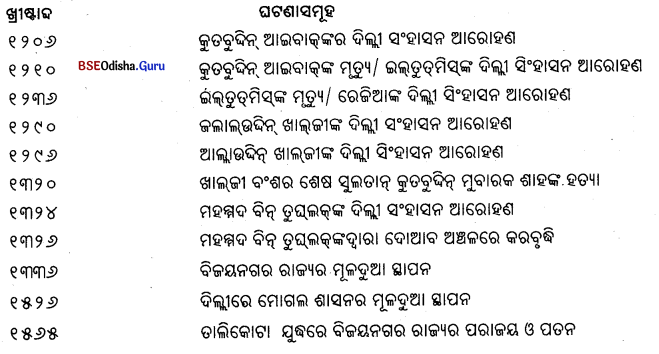
![]()
![]()
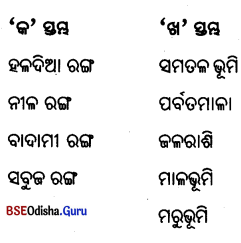
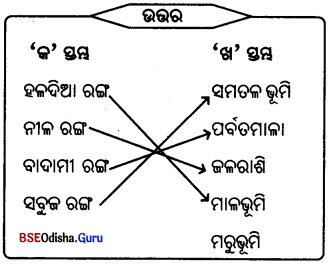
![]()
![]()
![]()

